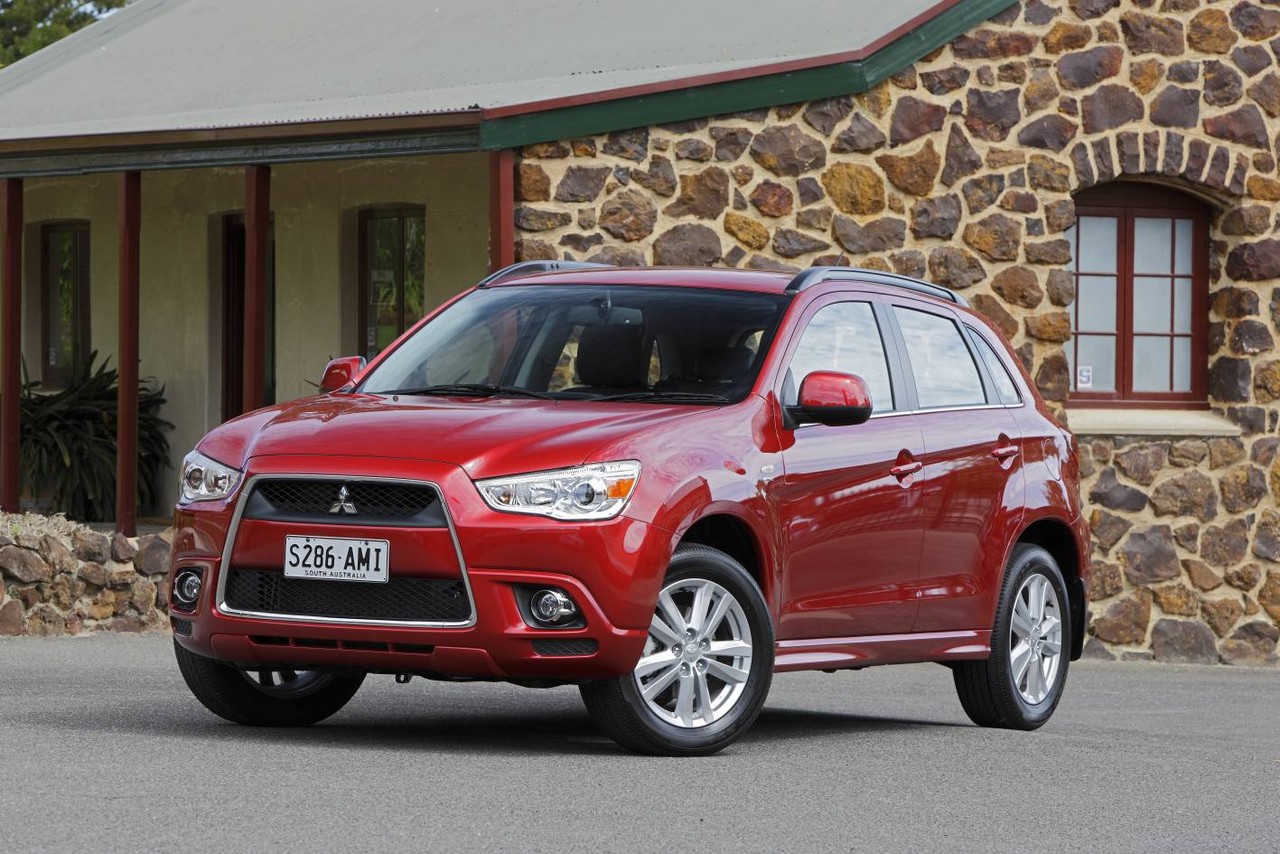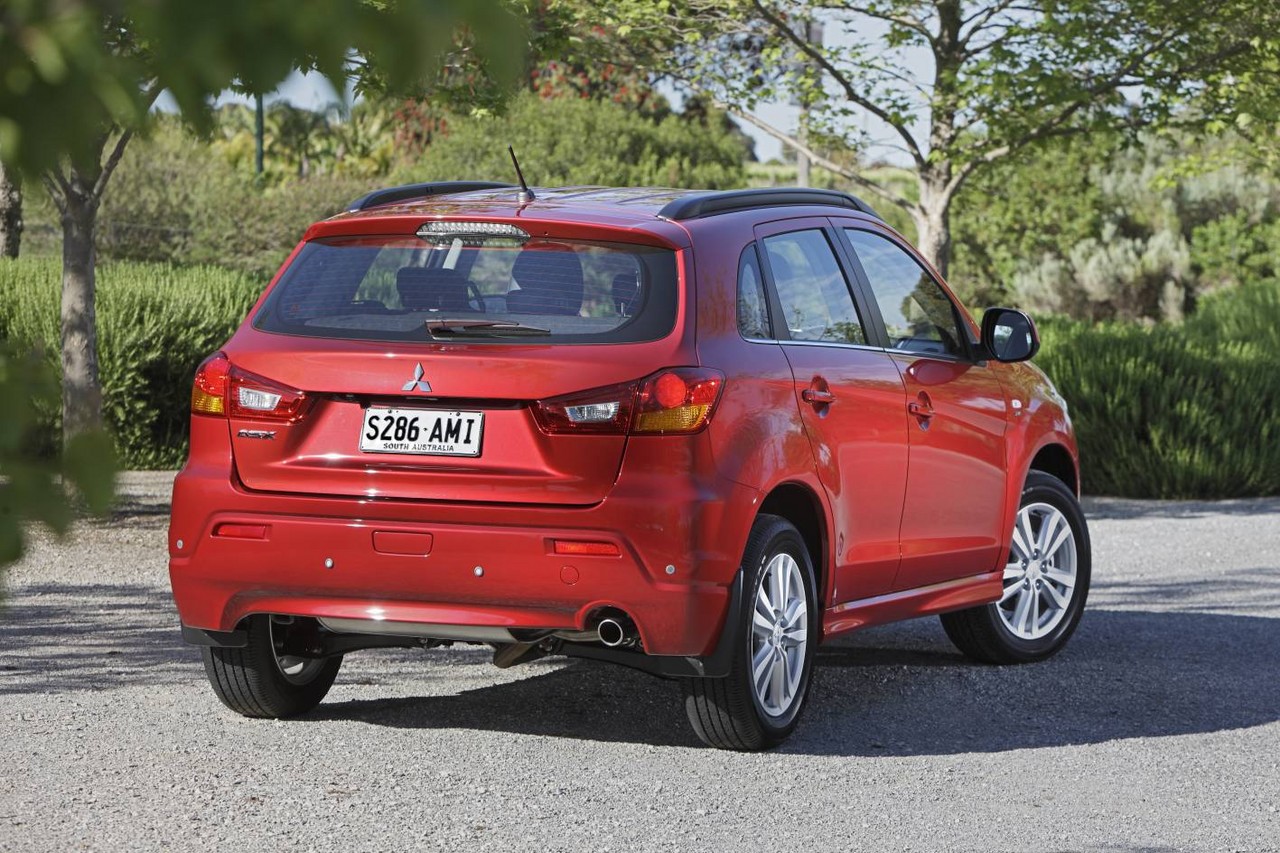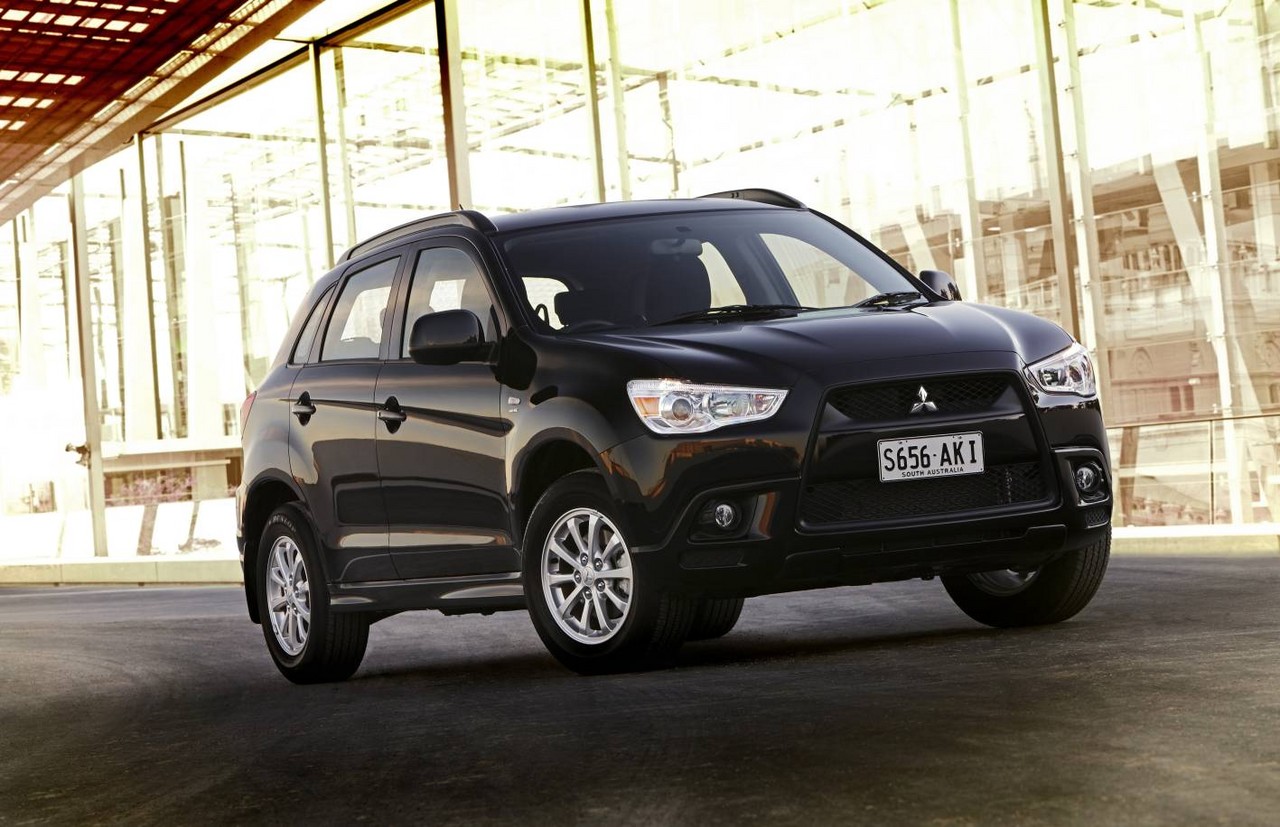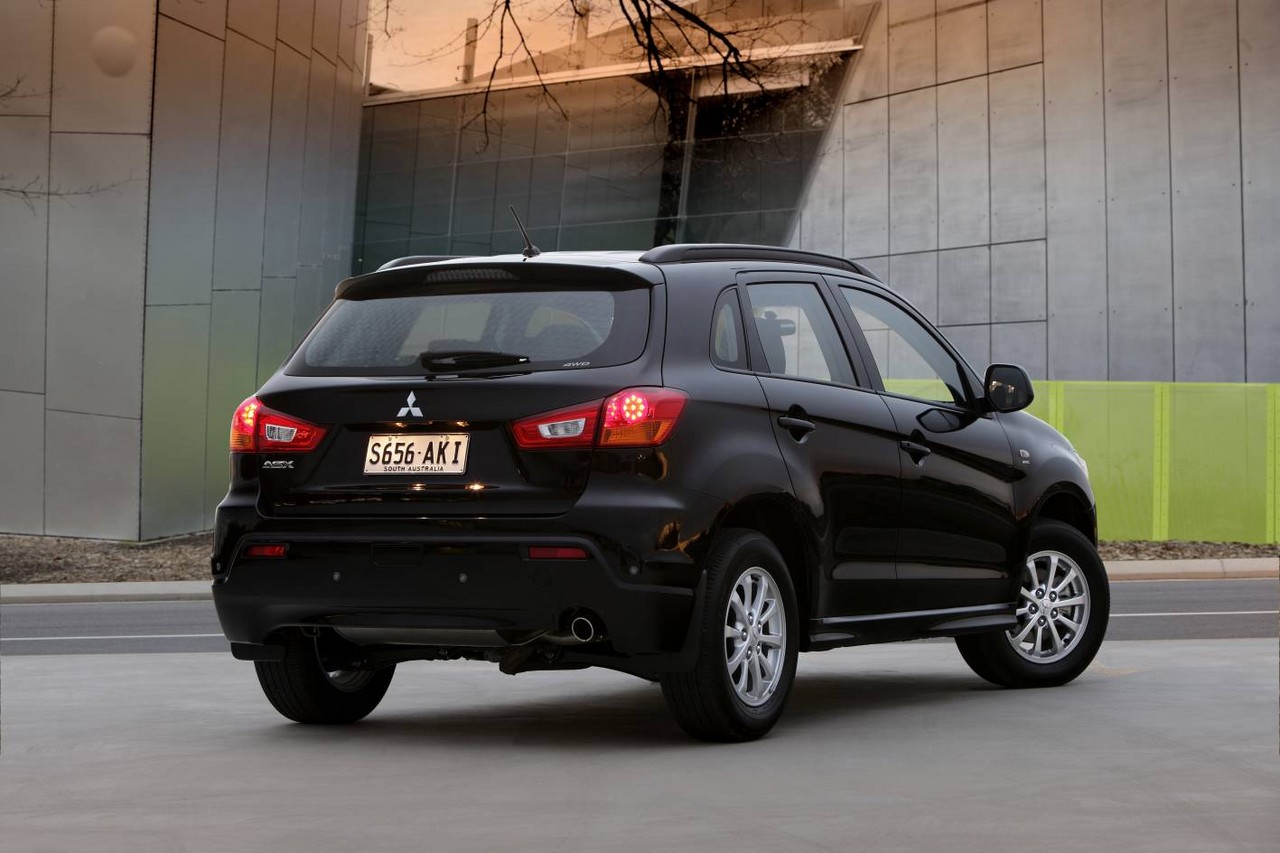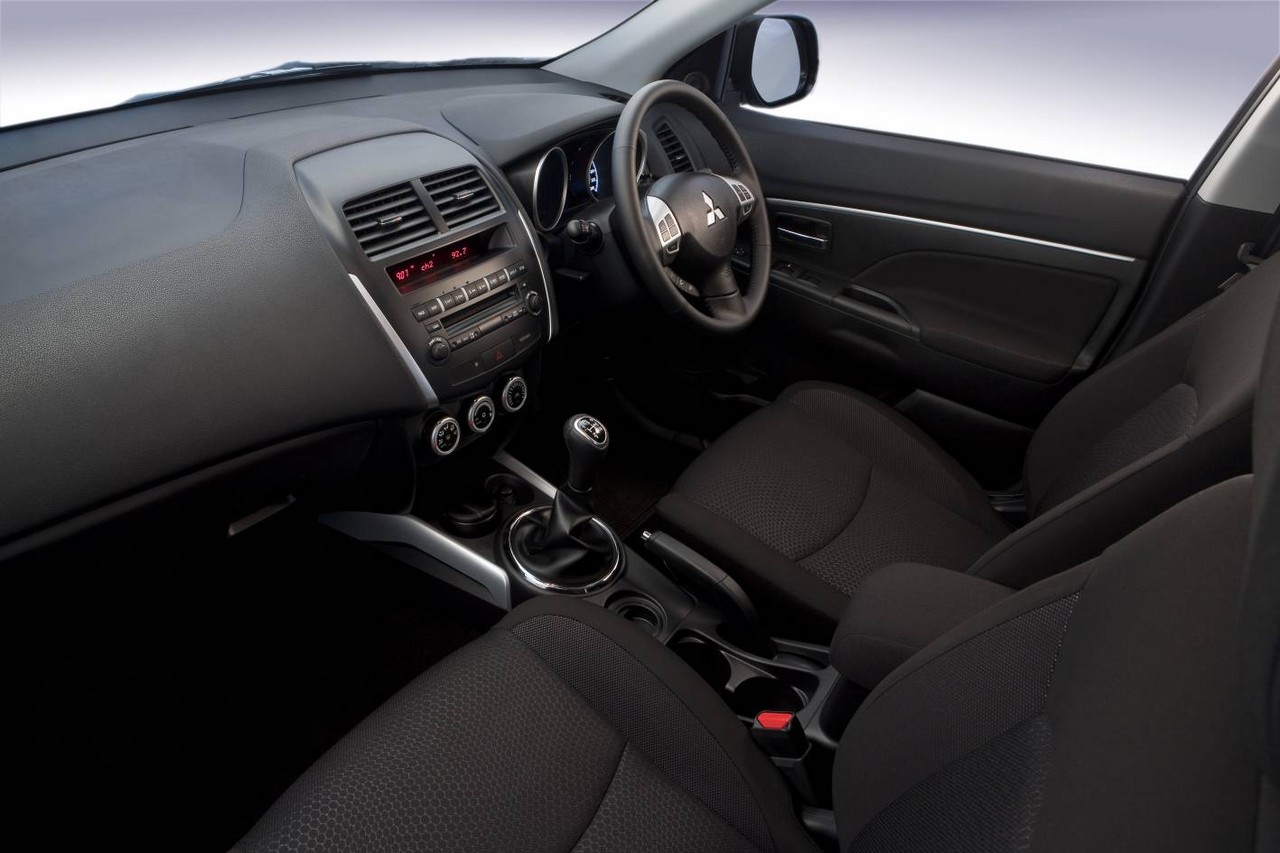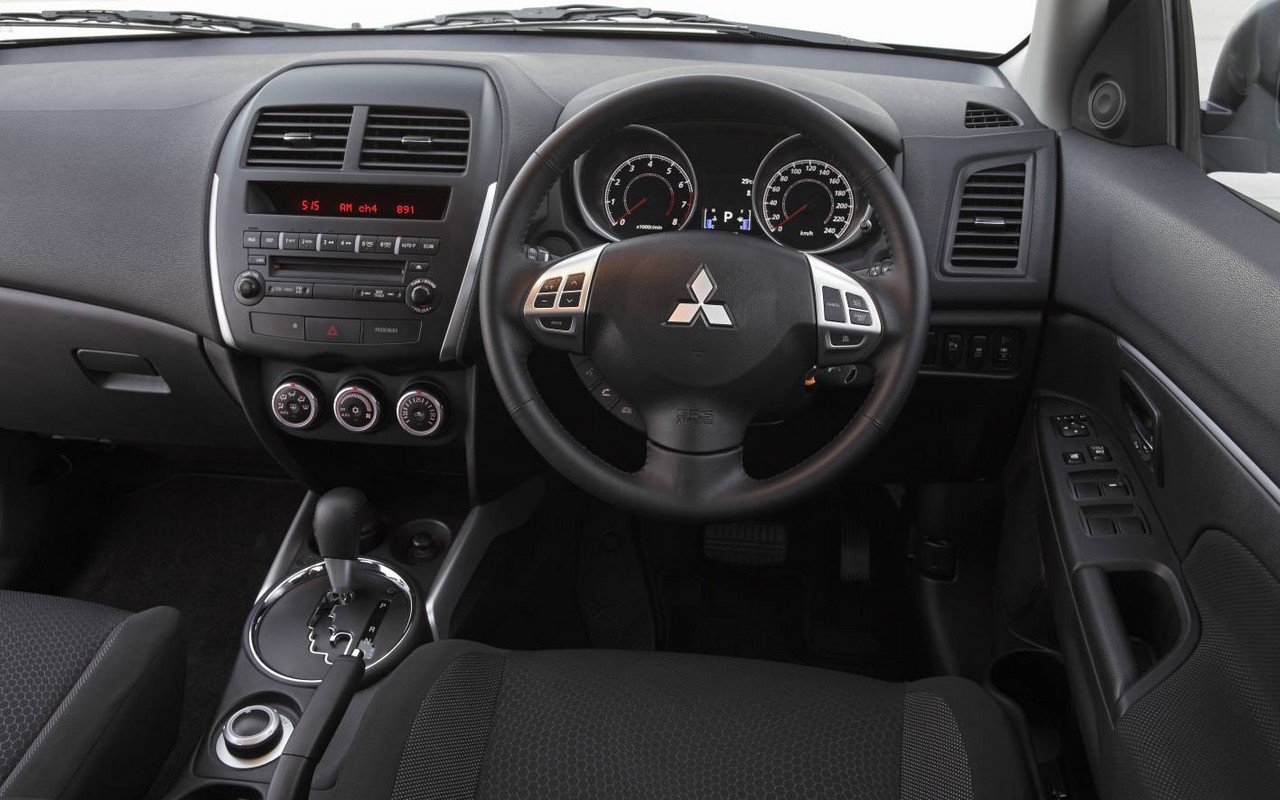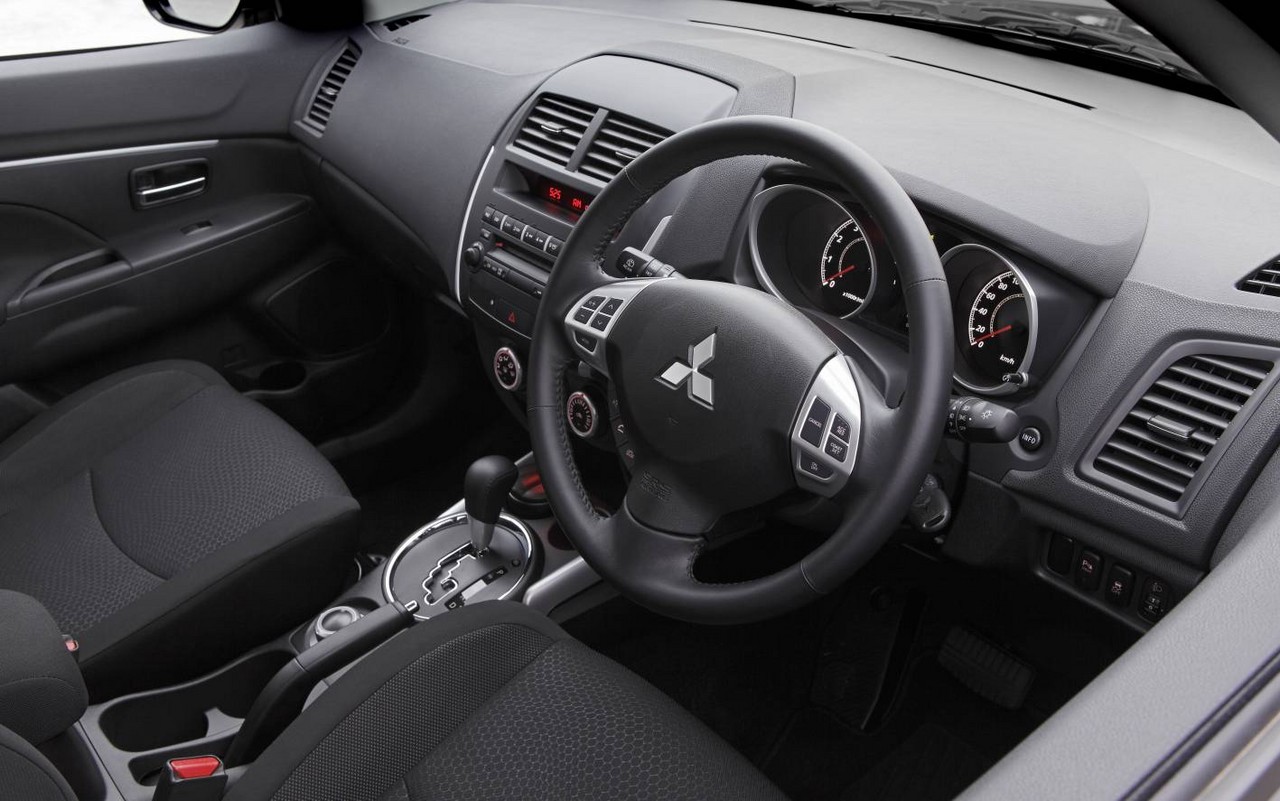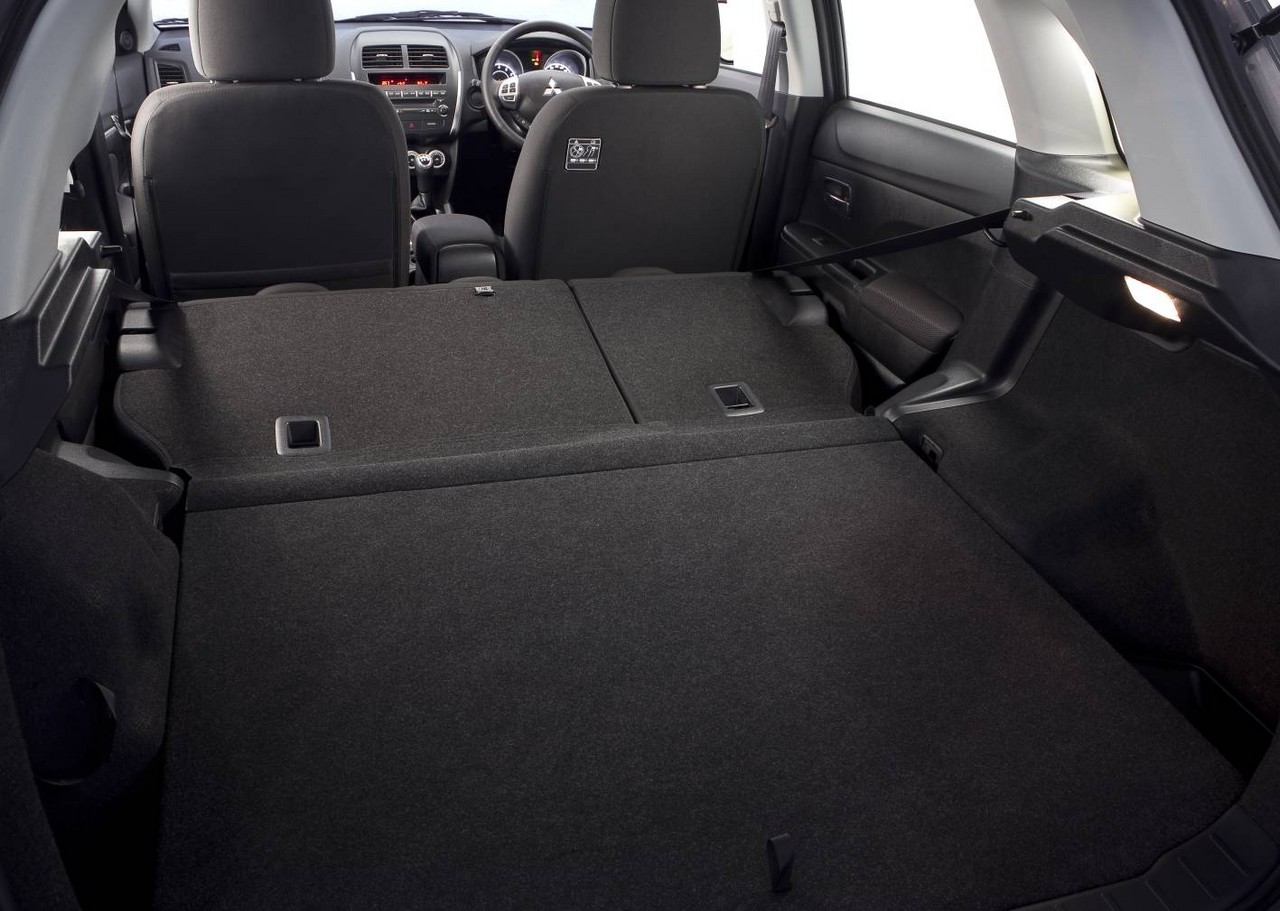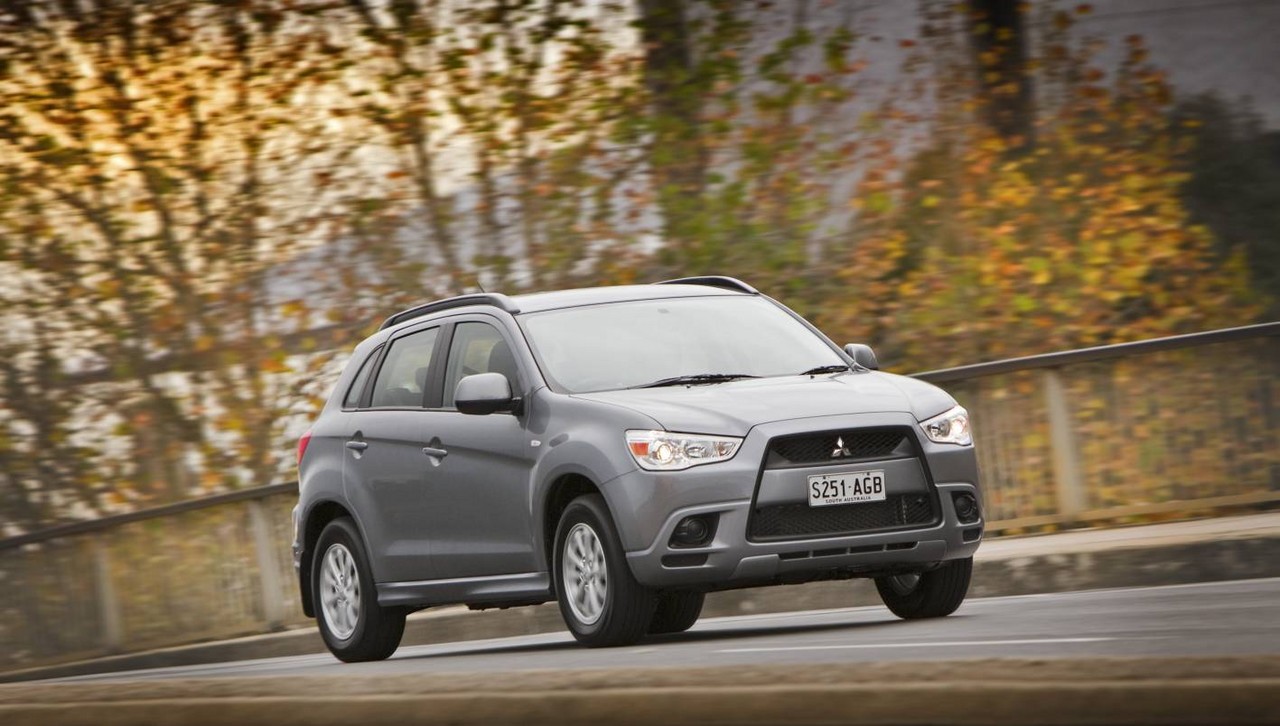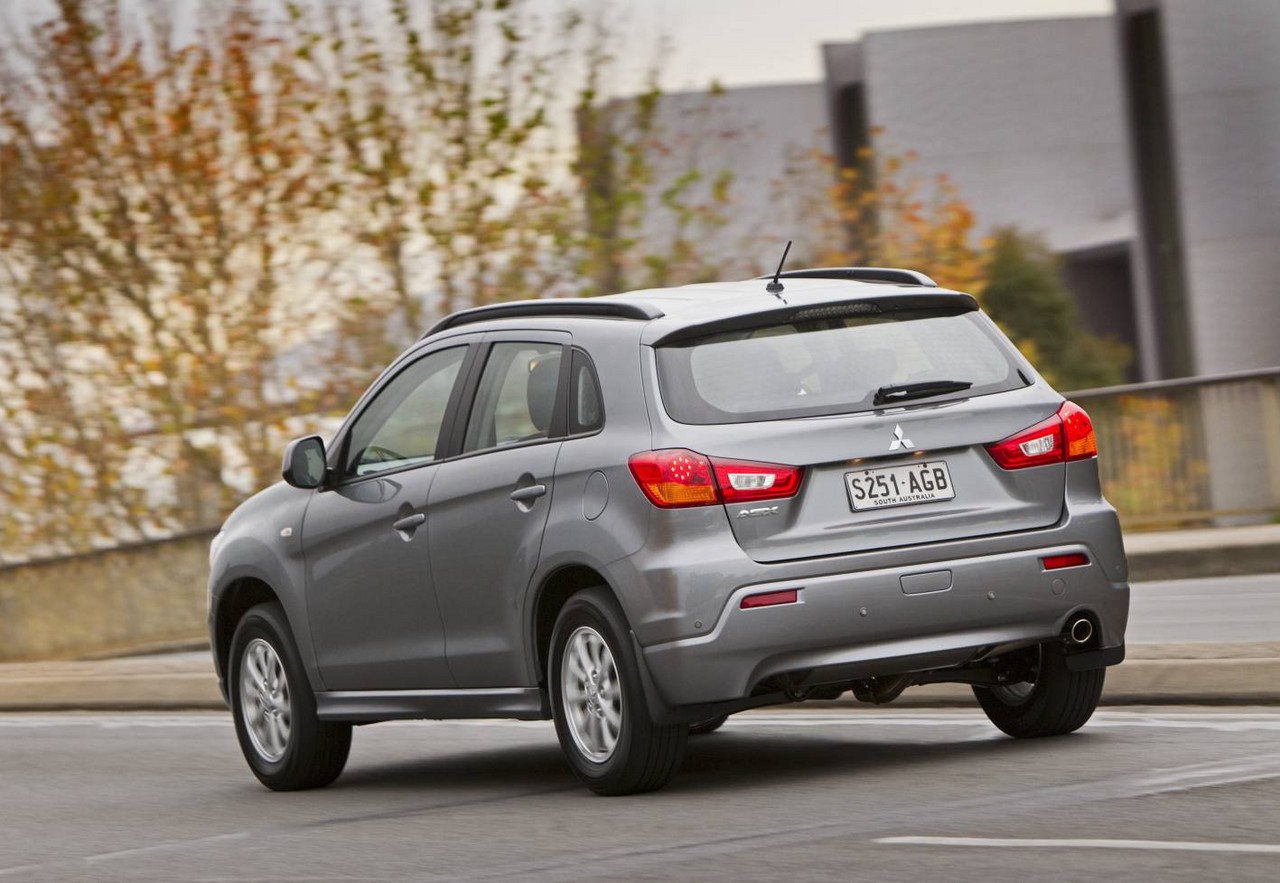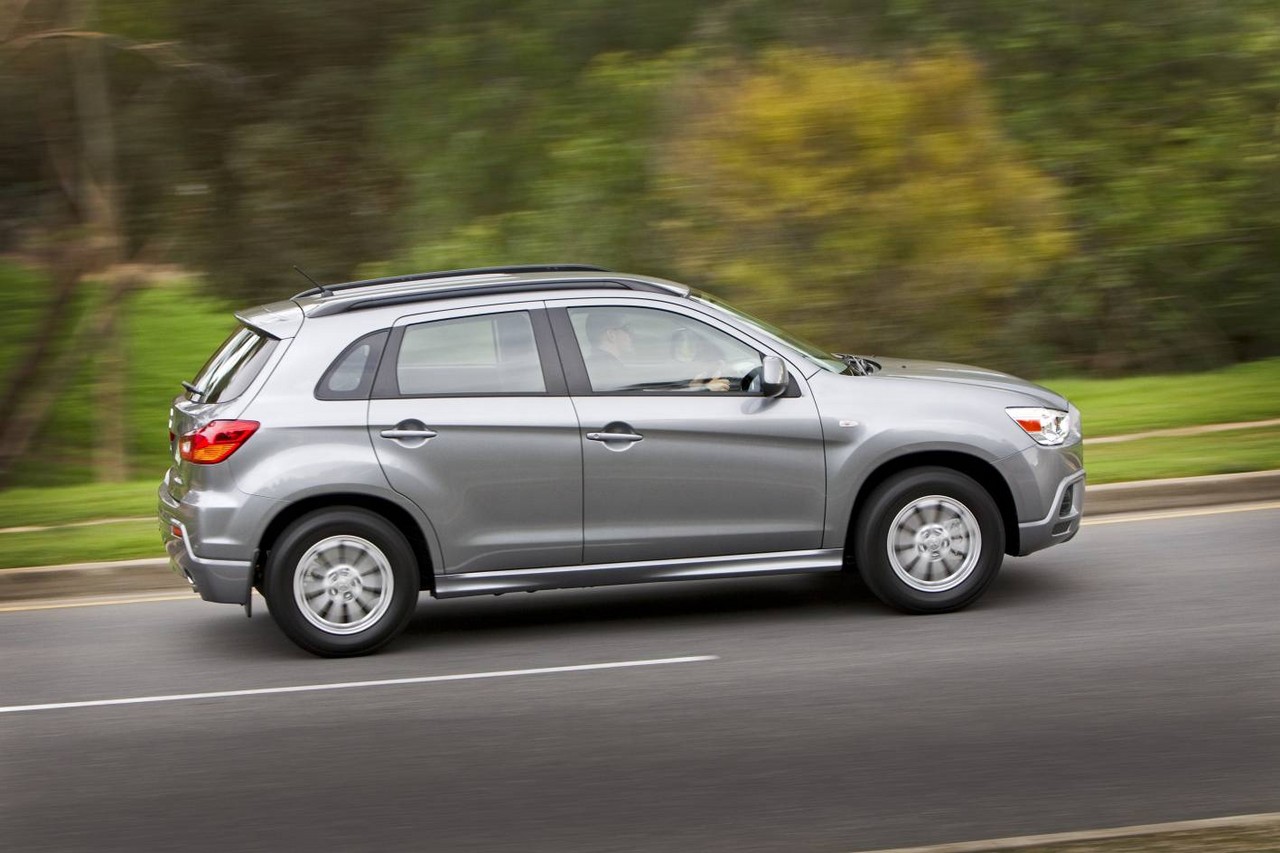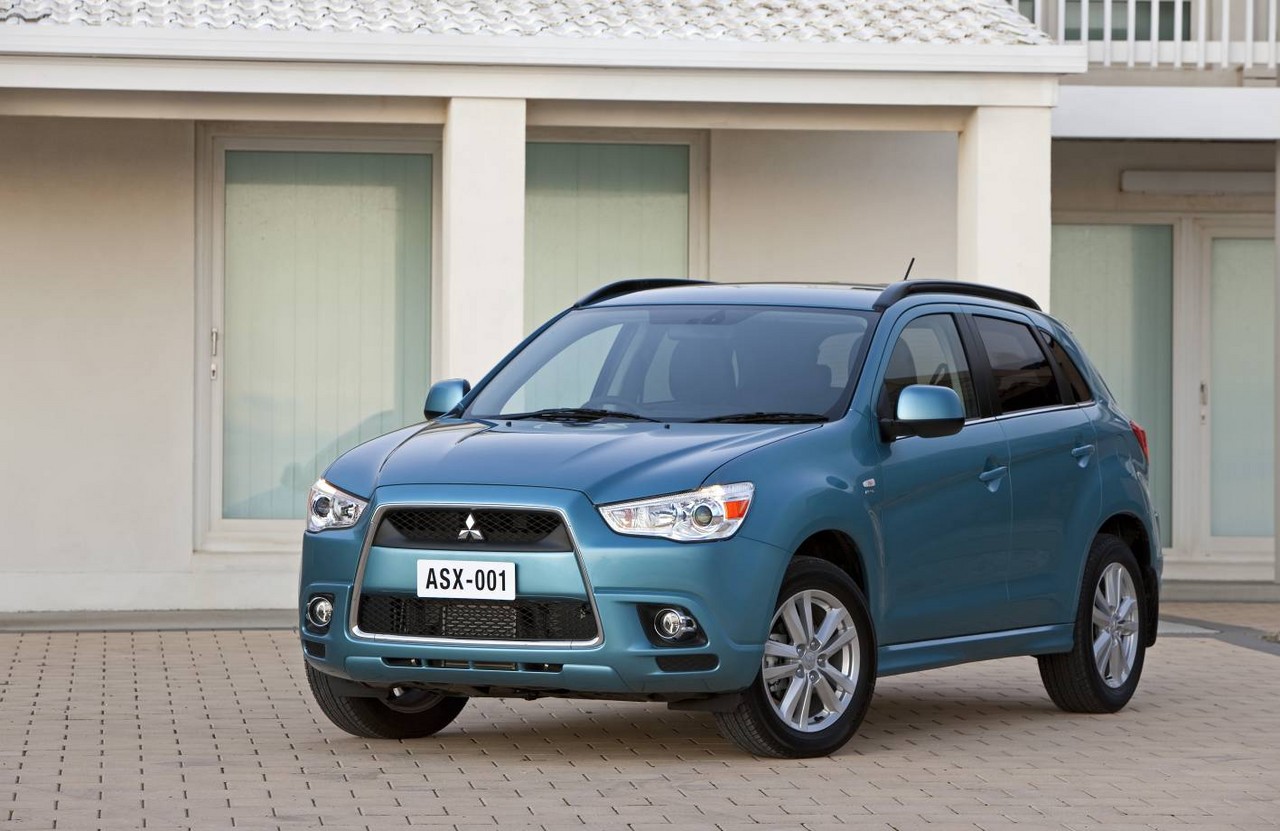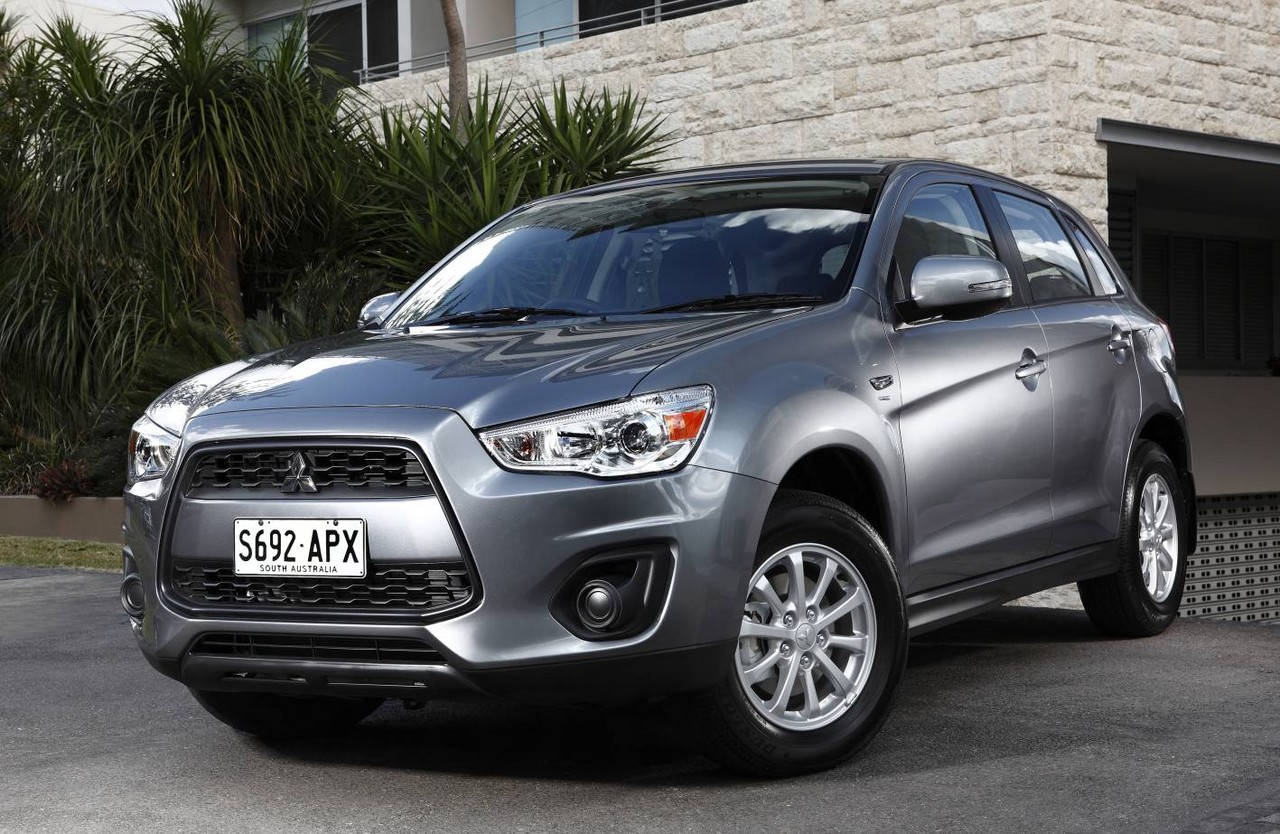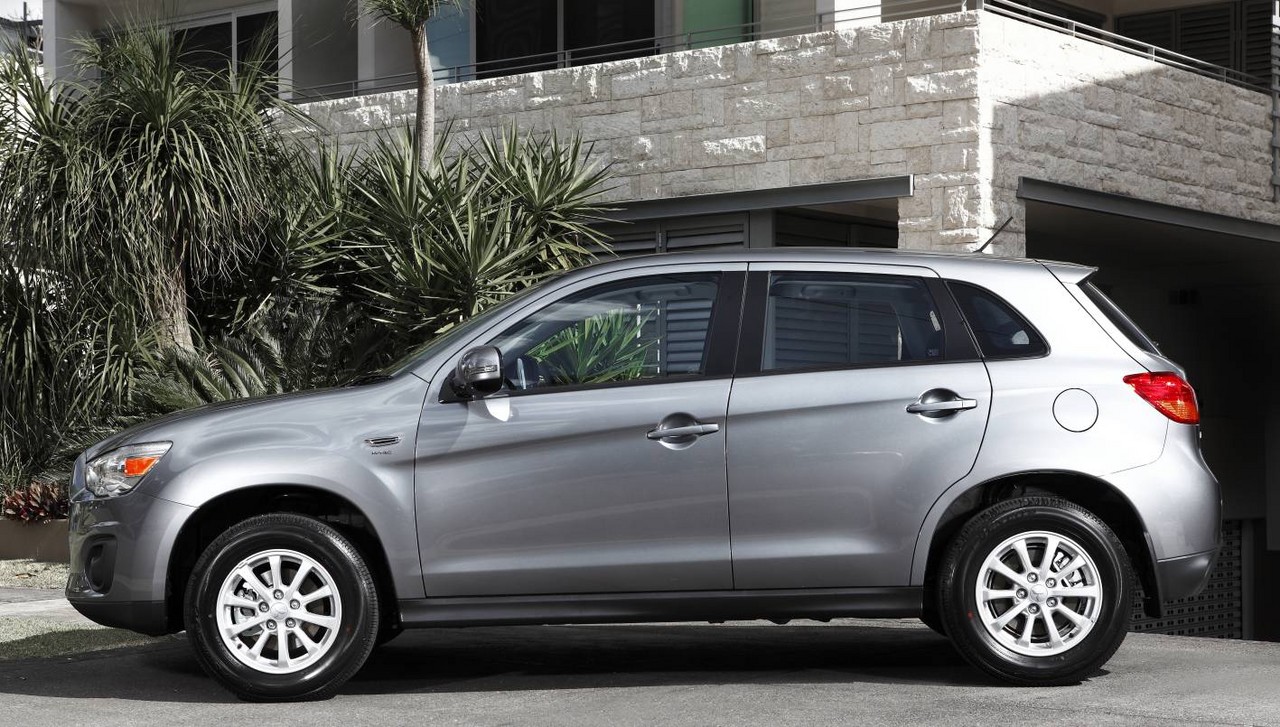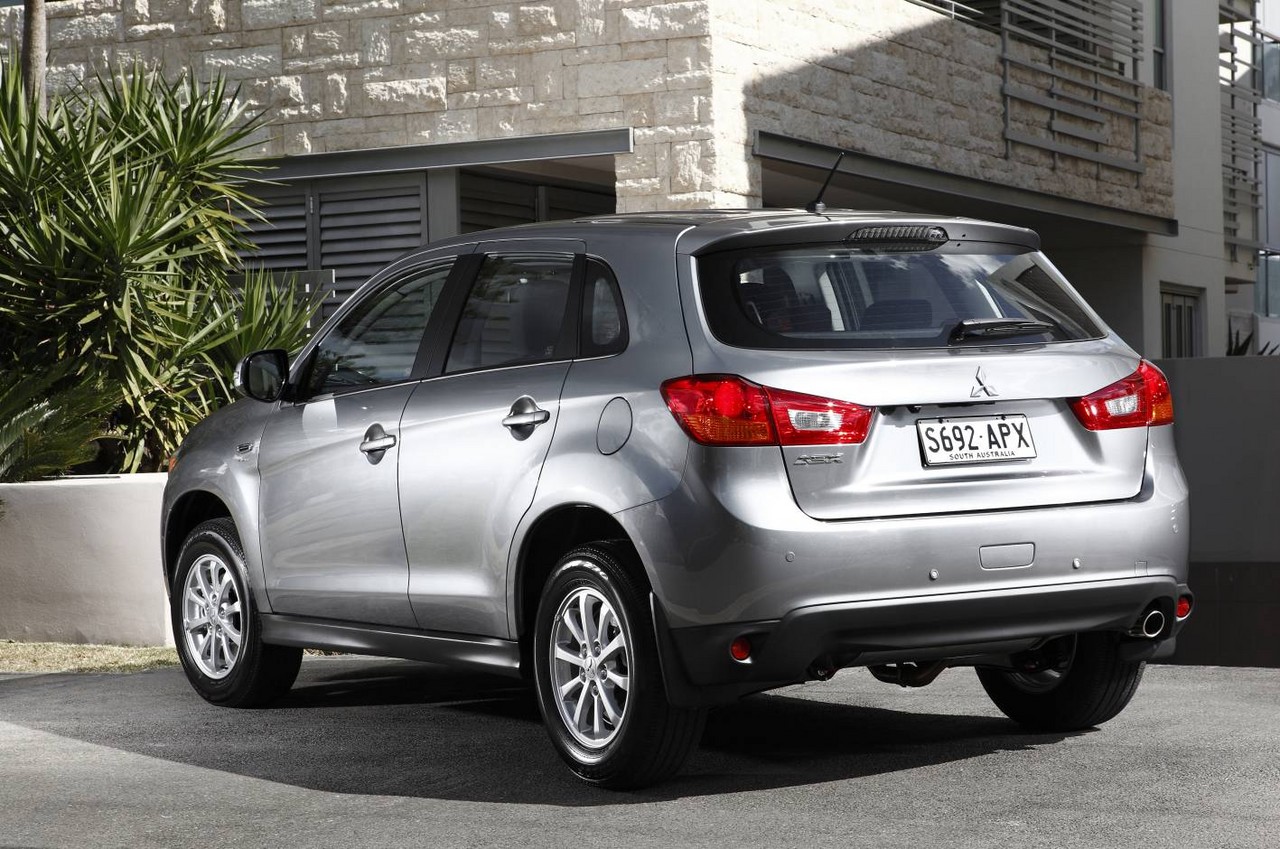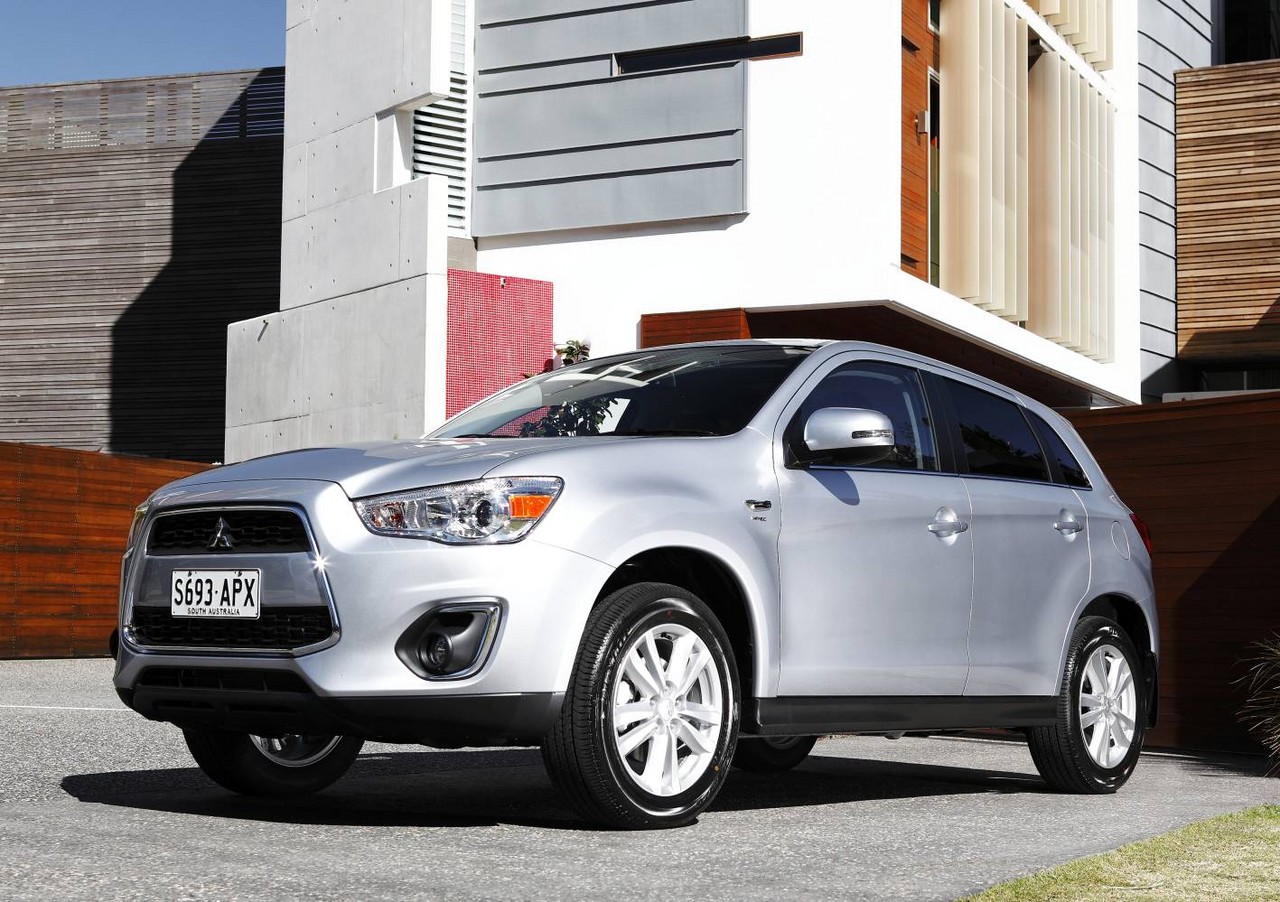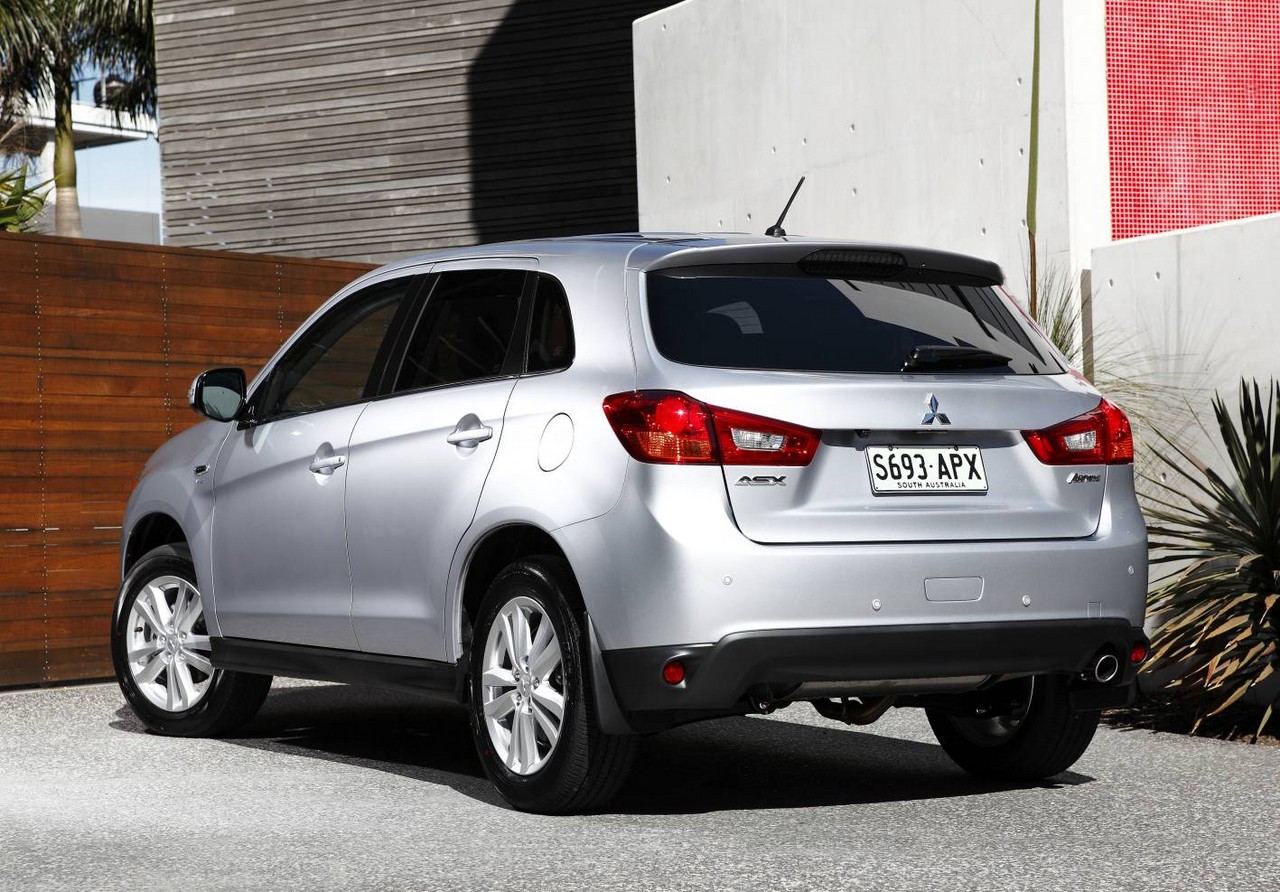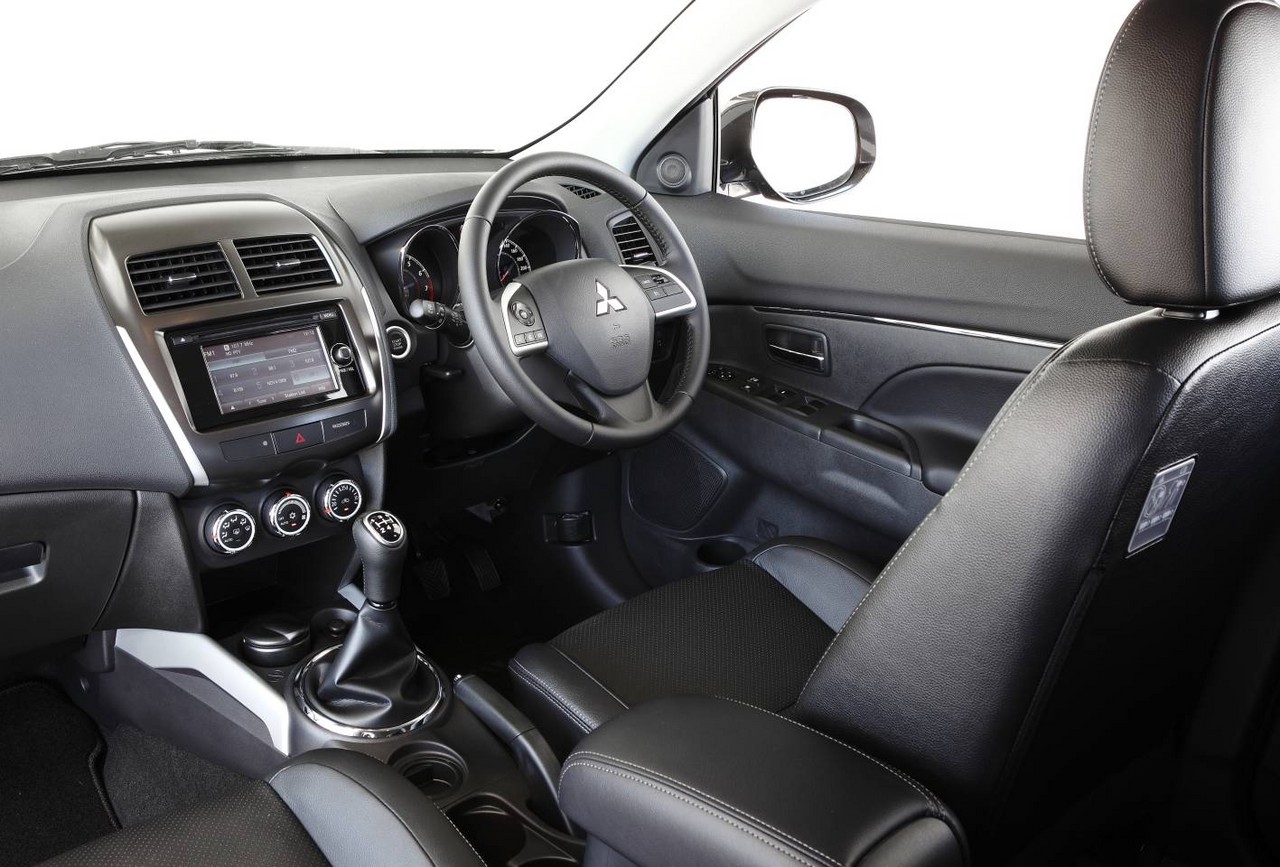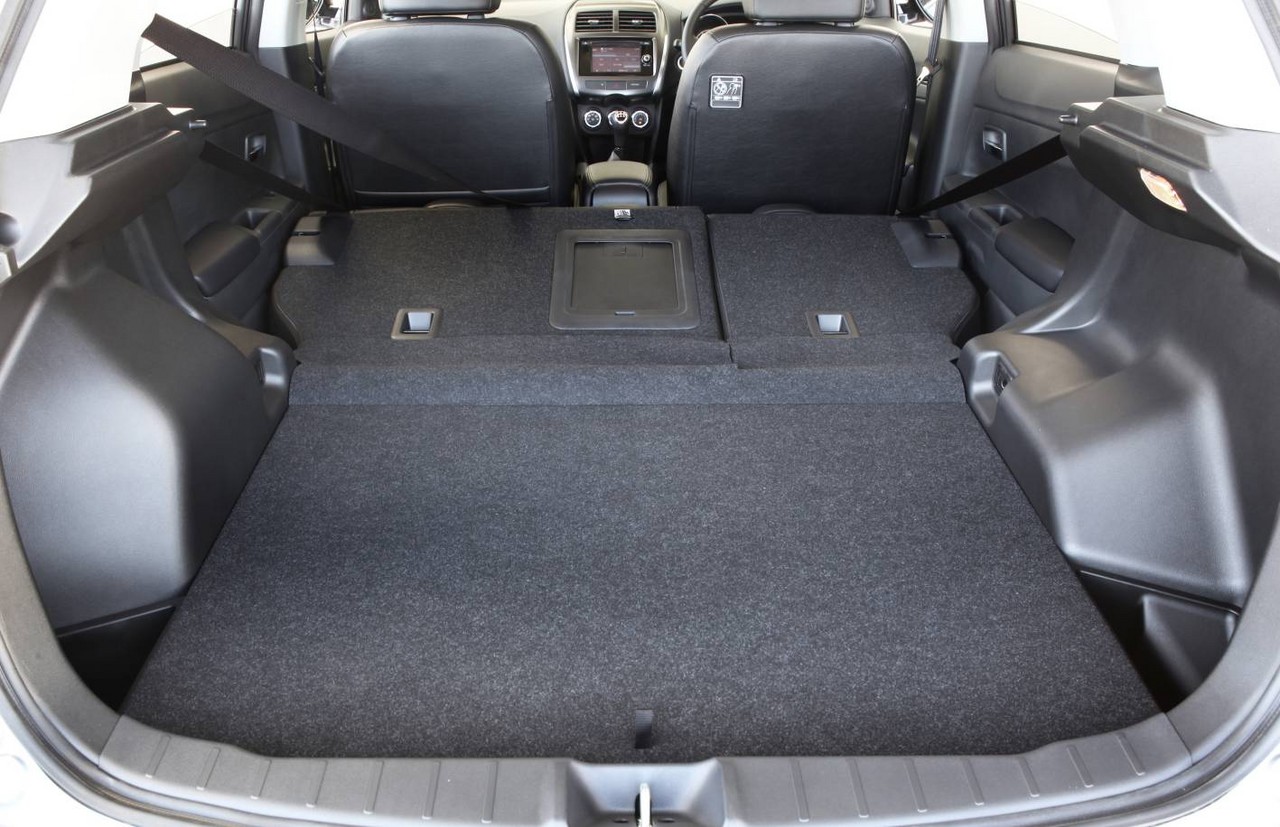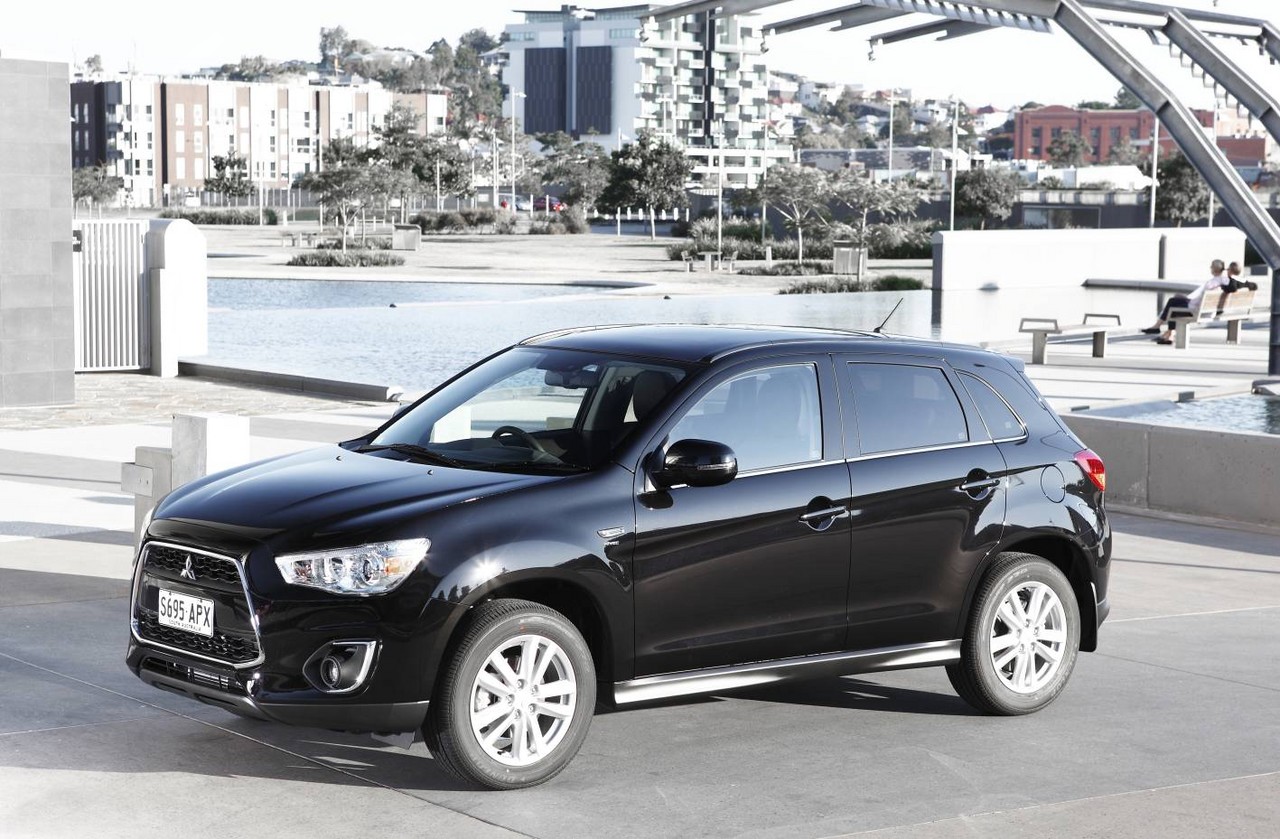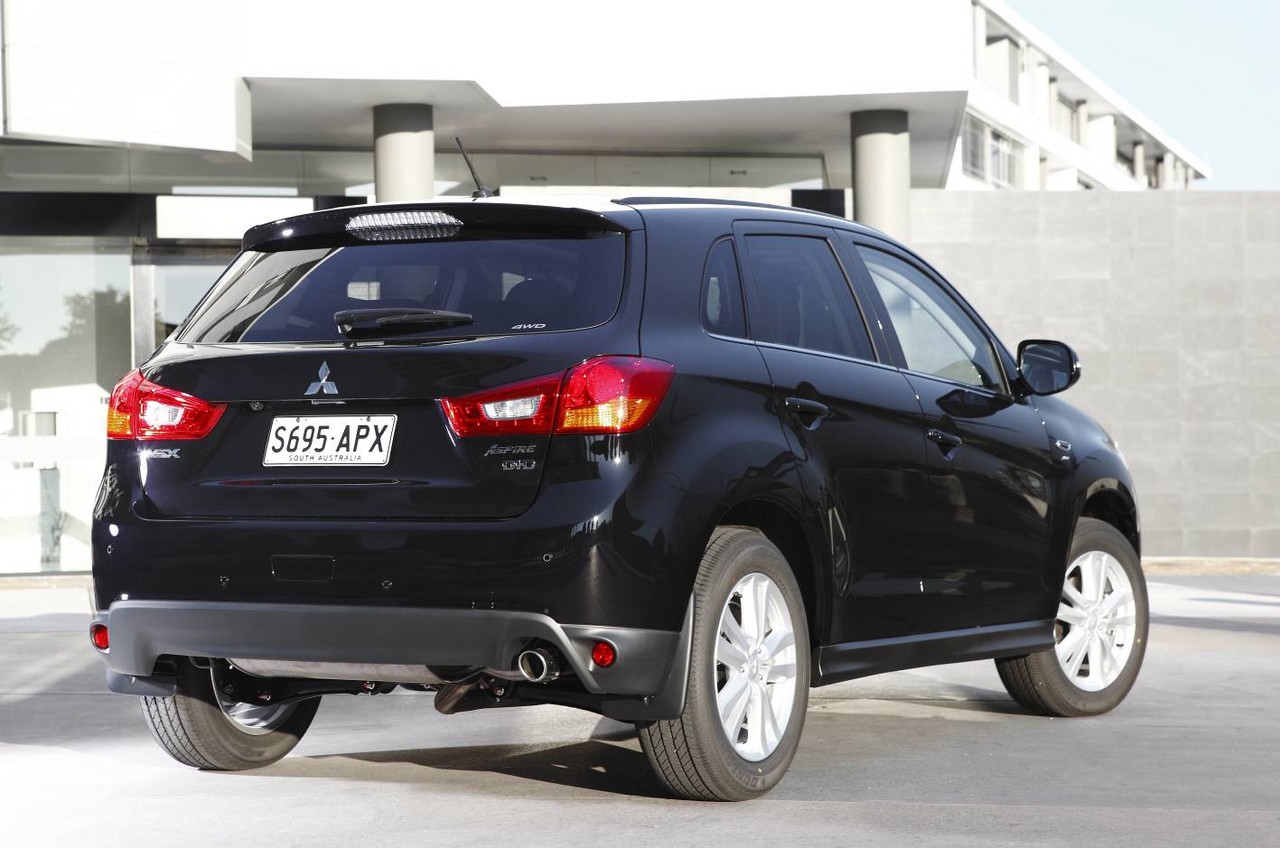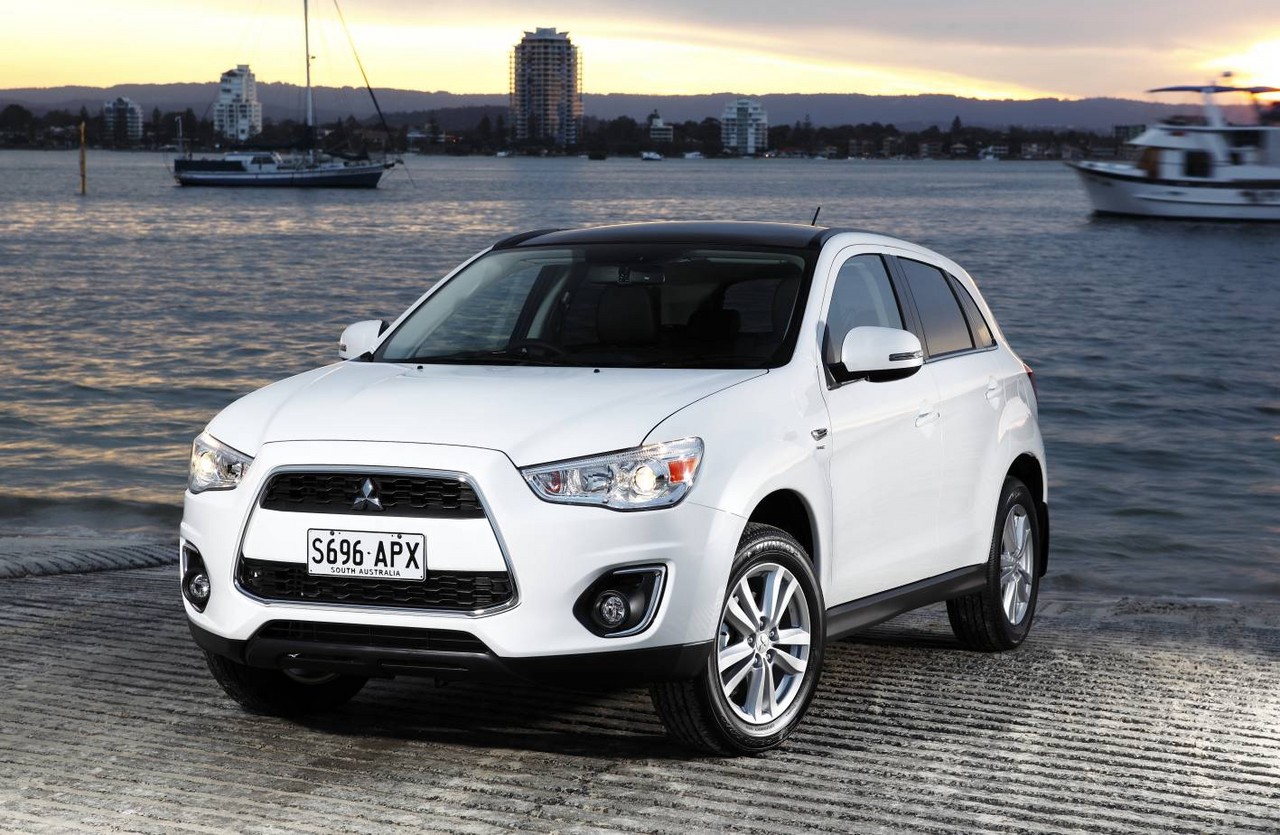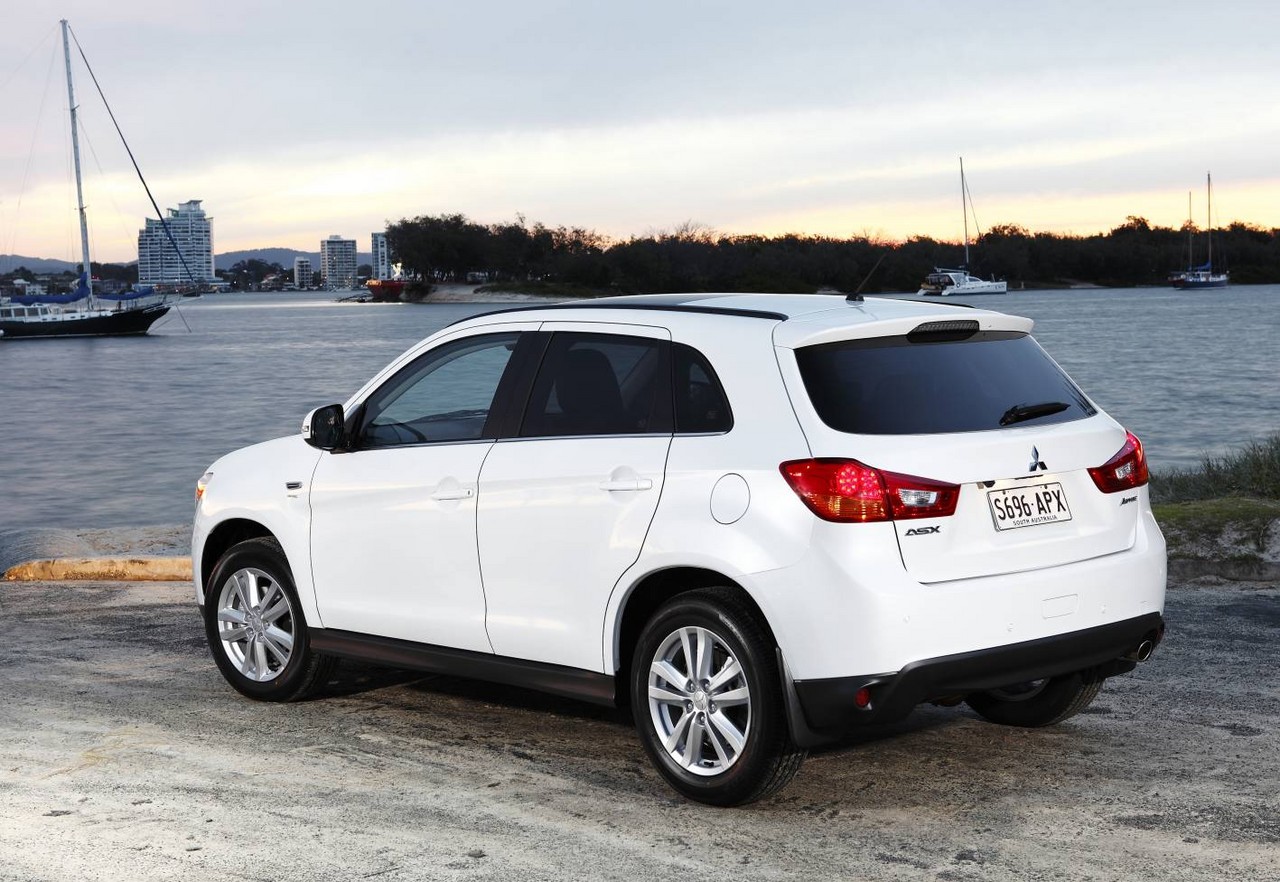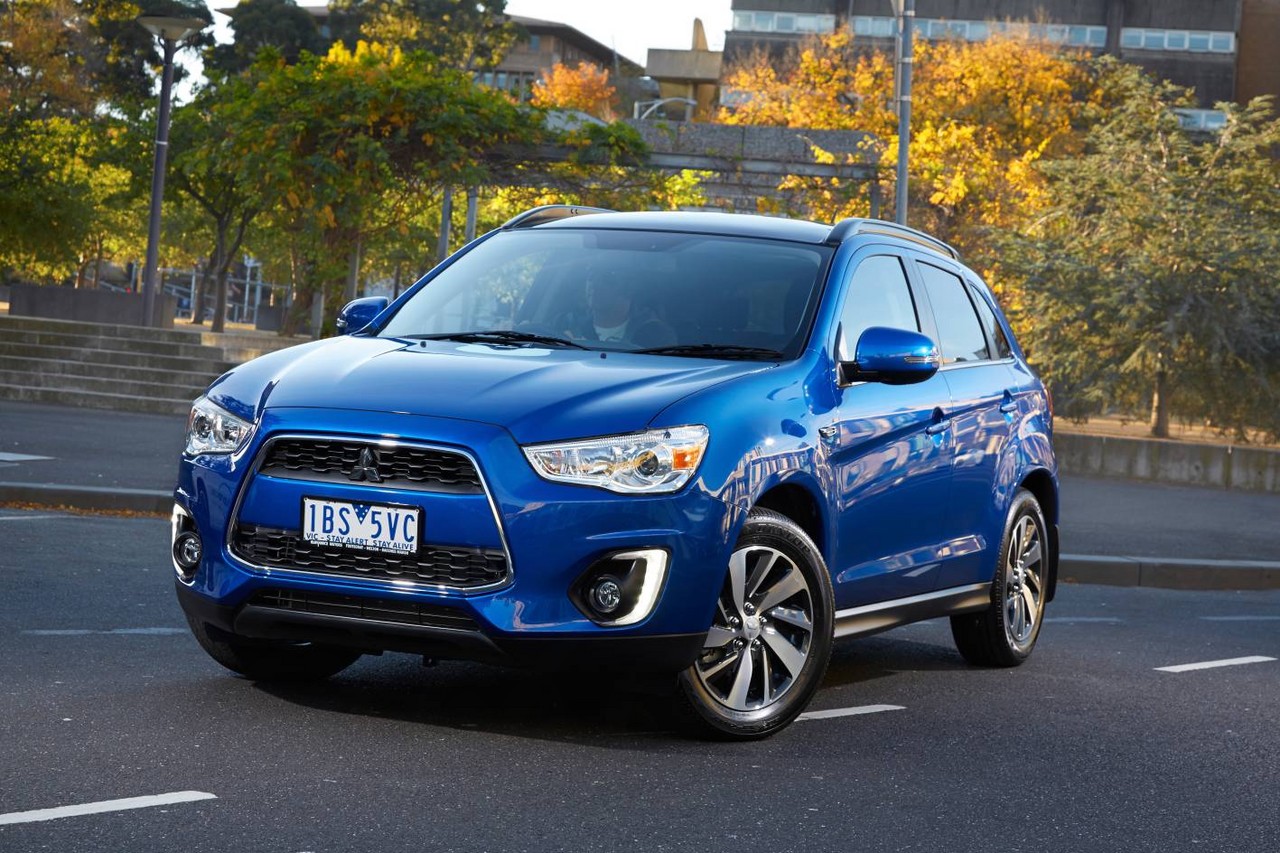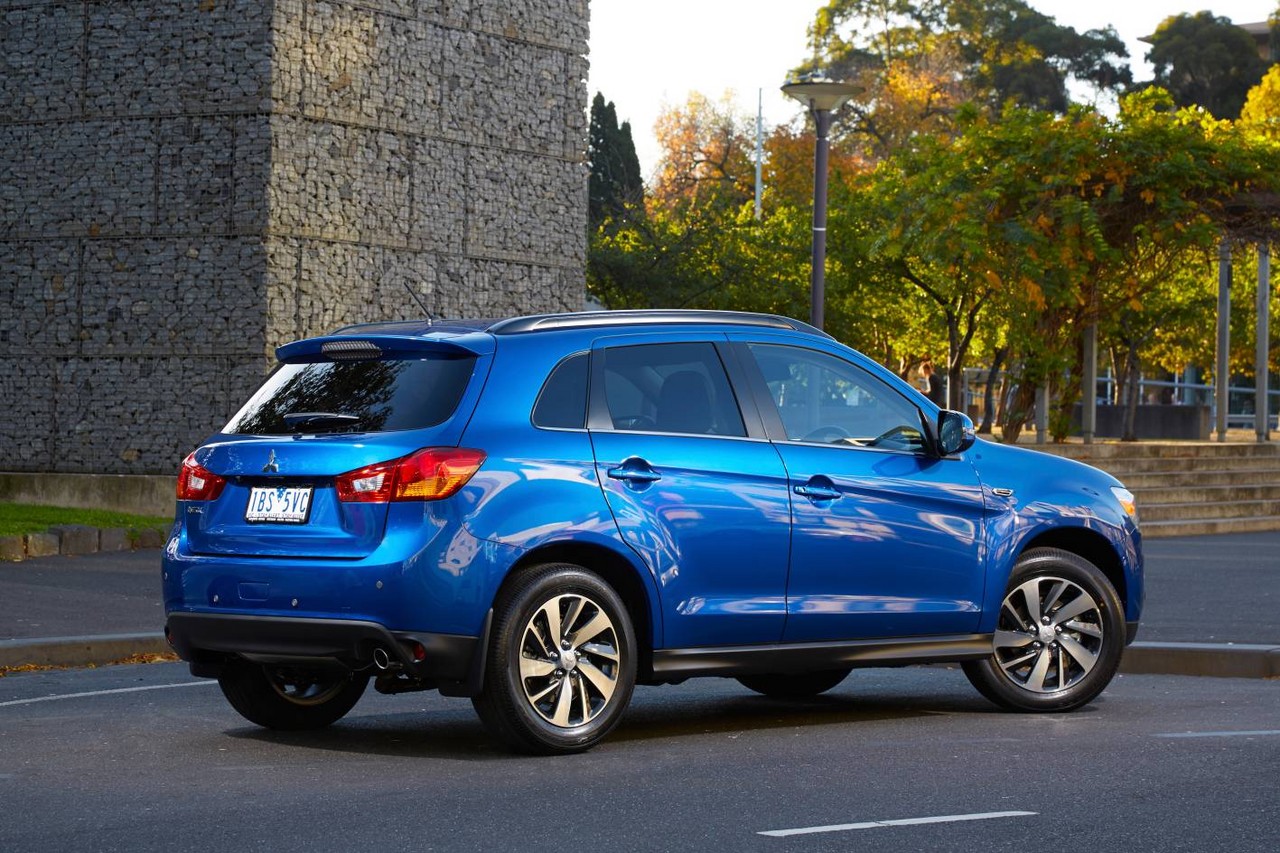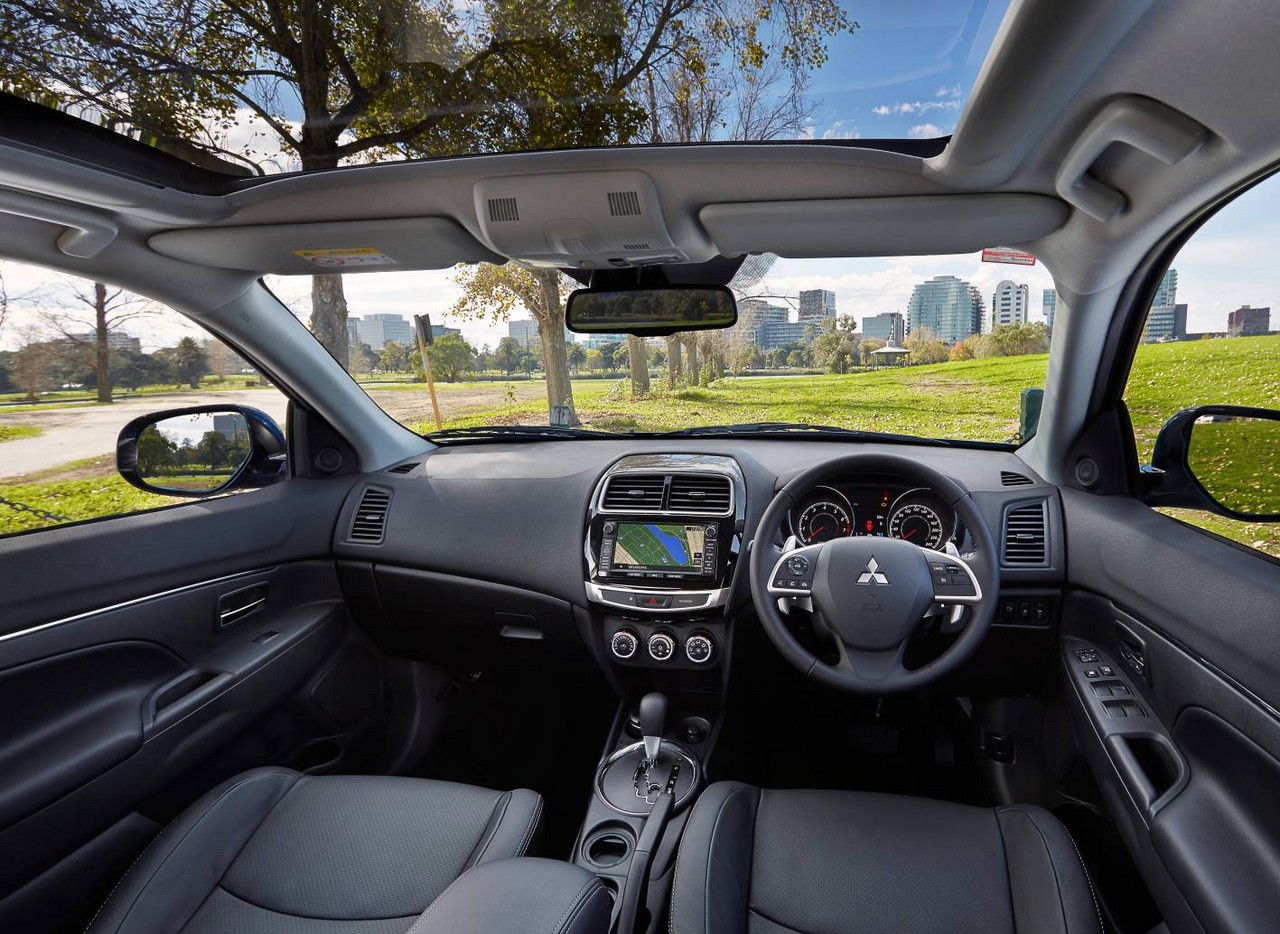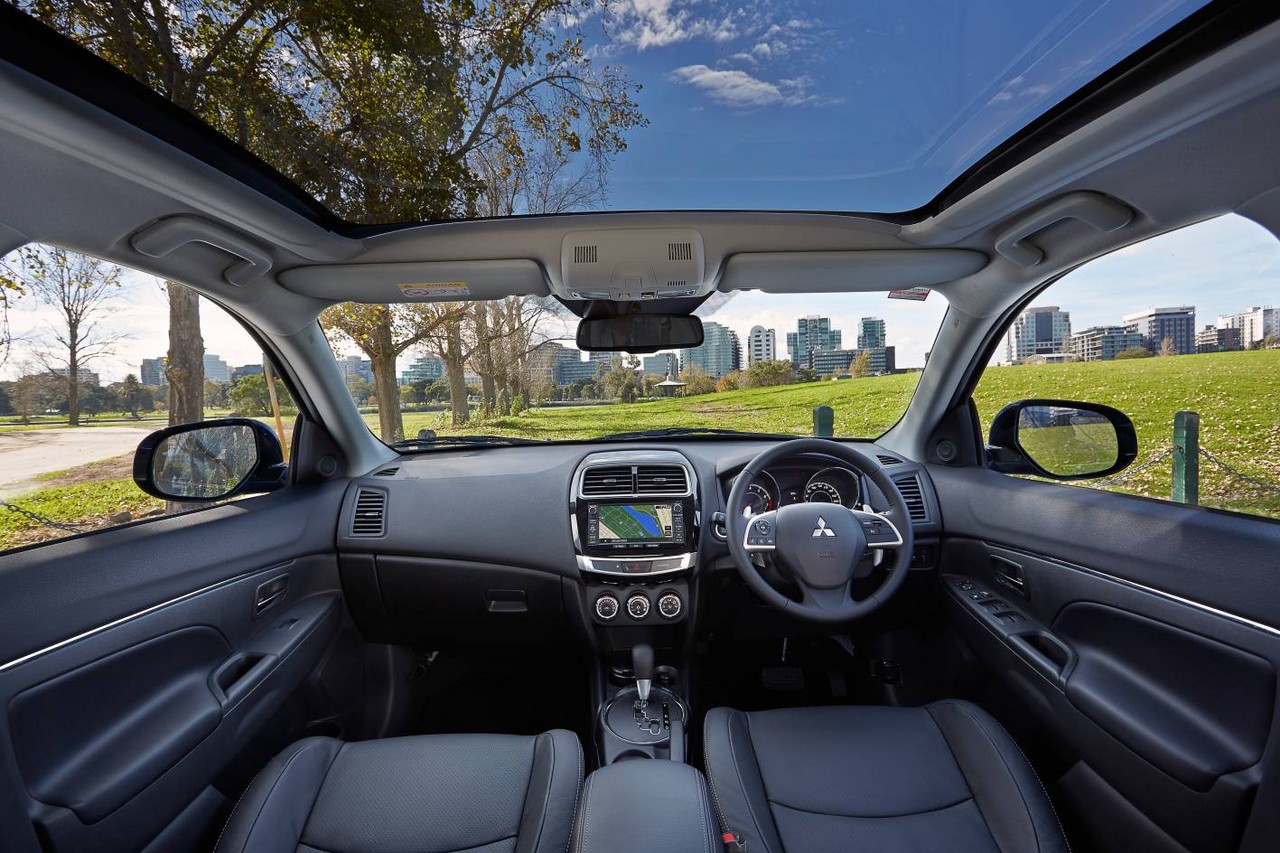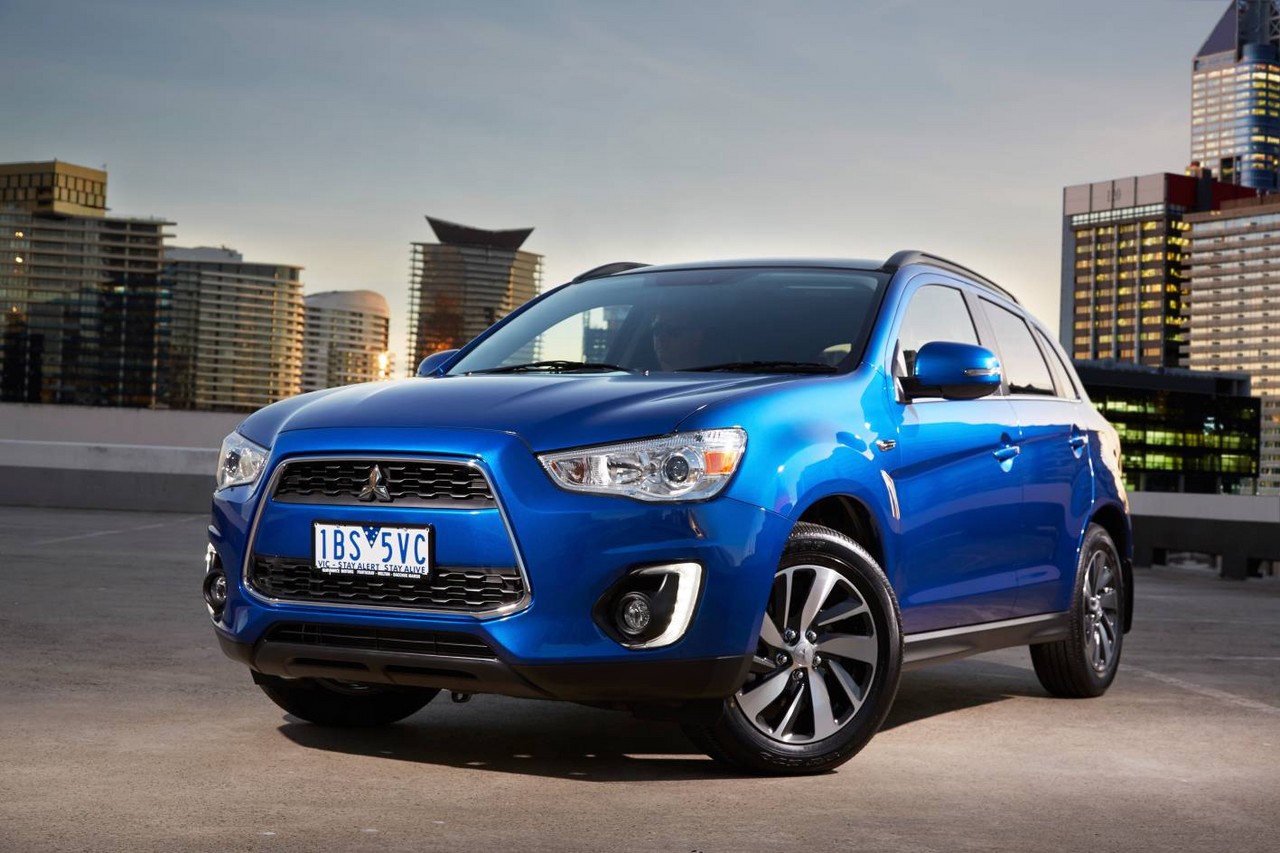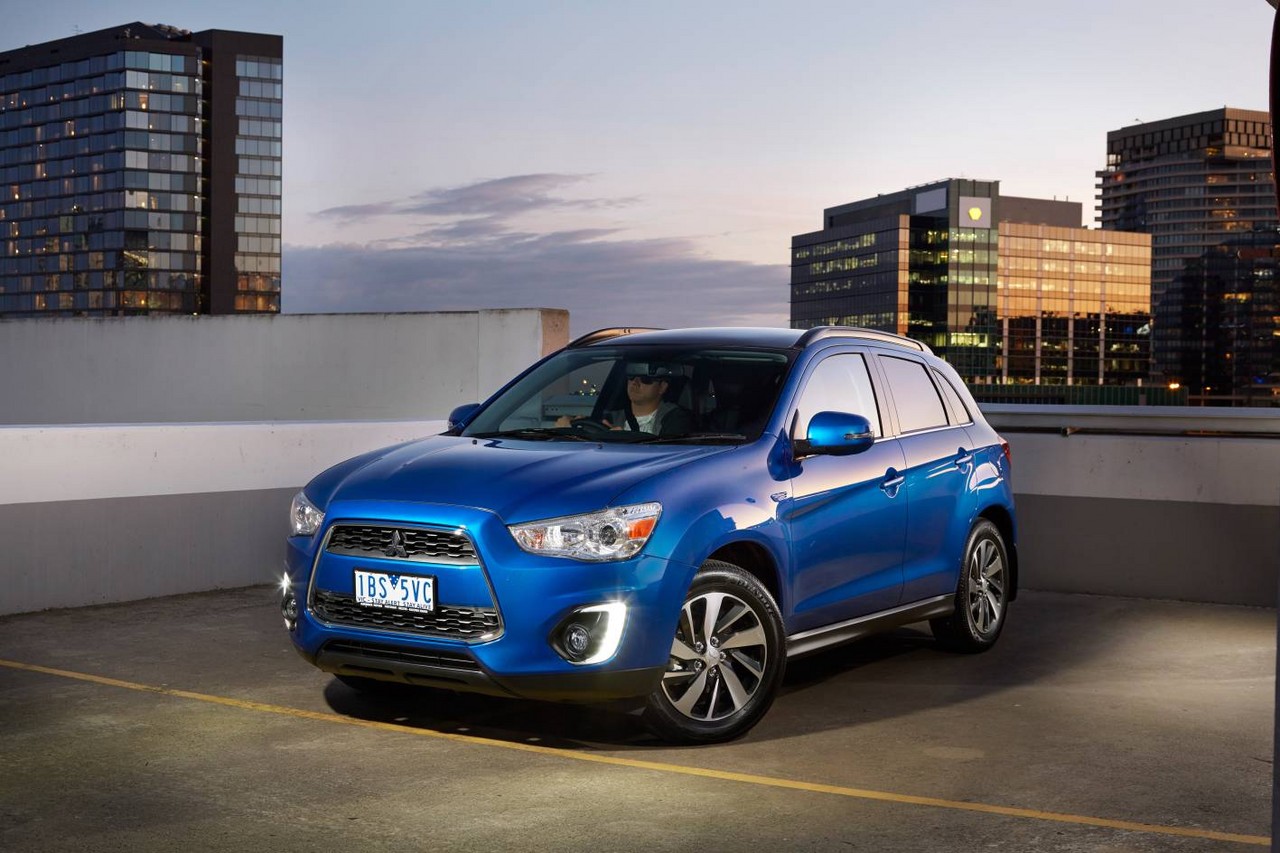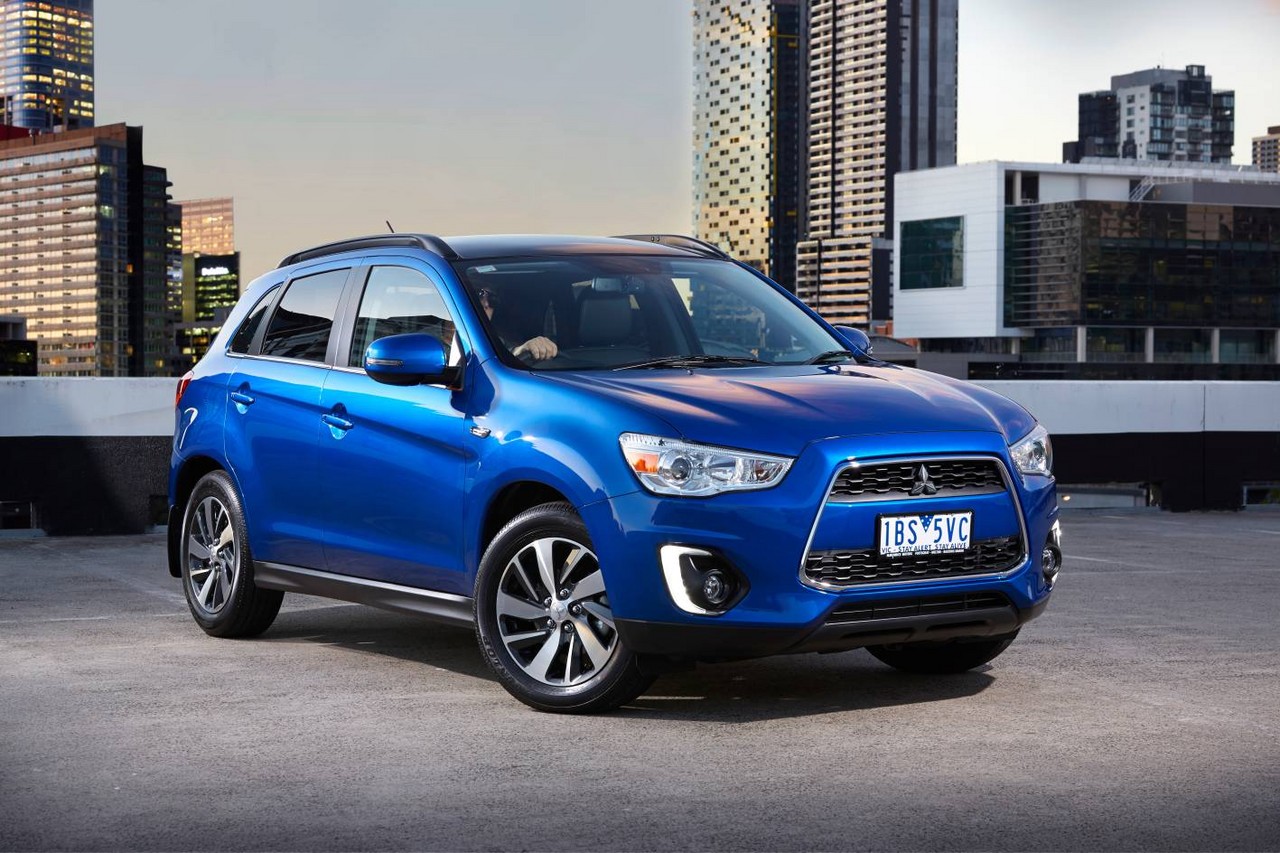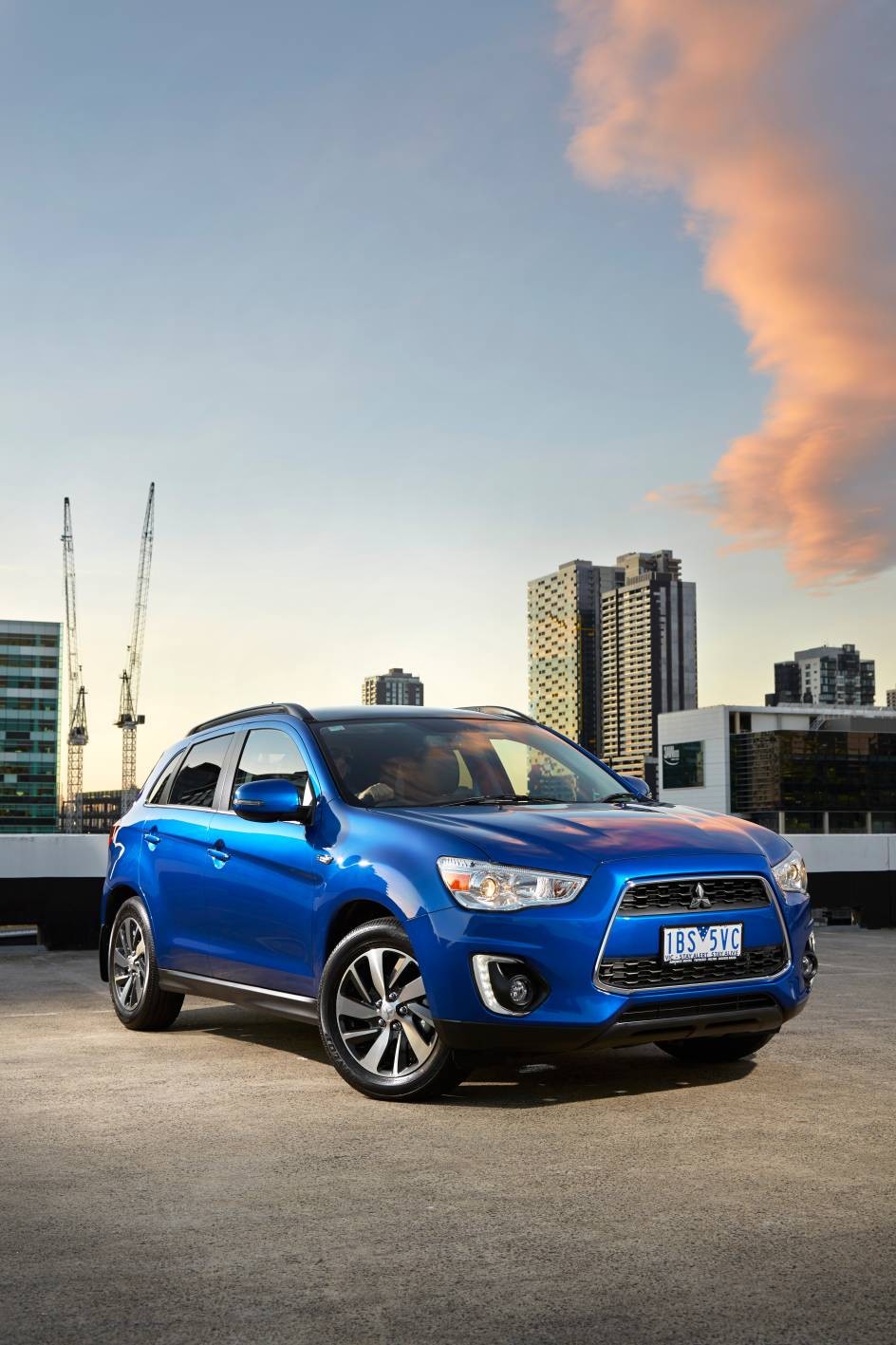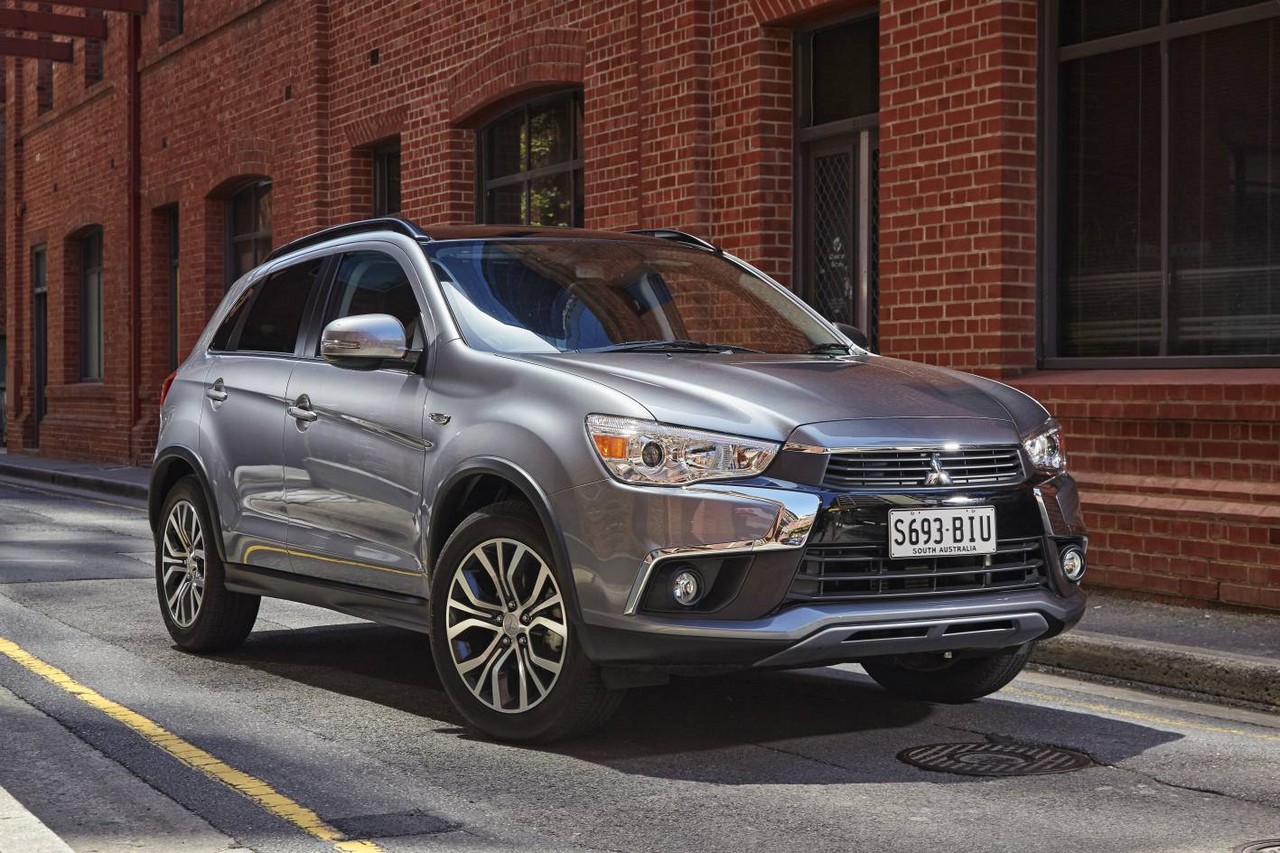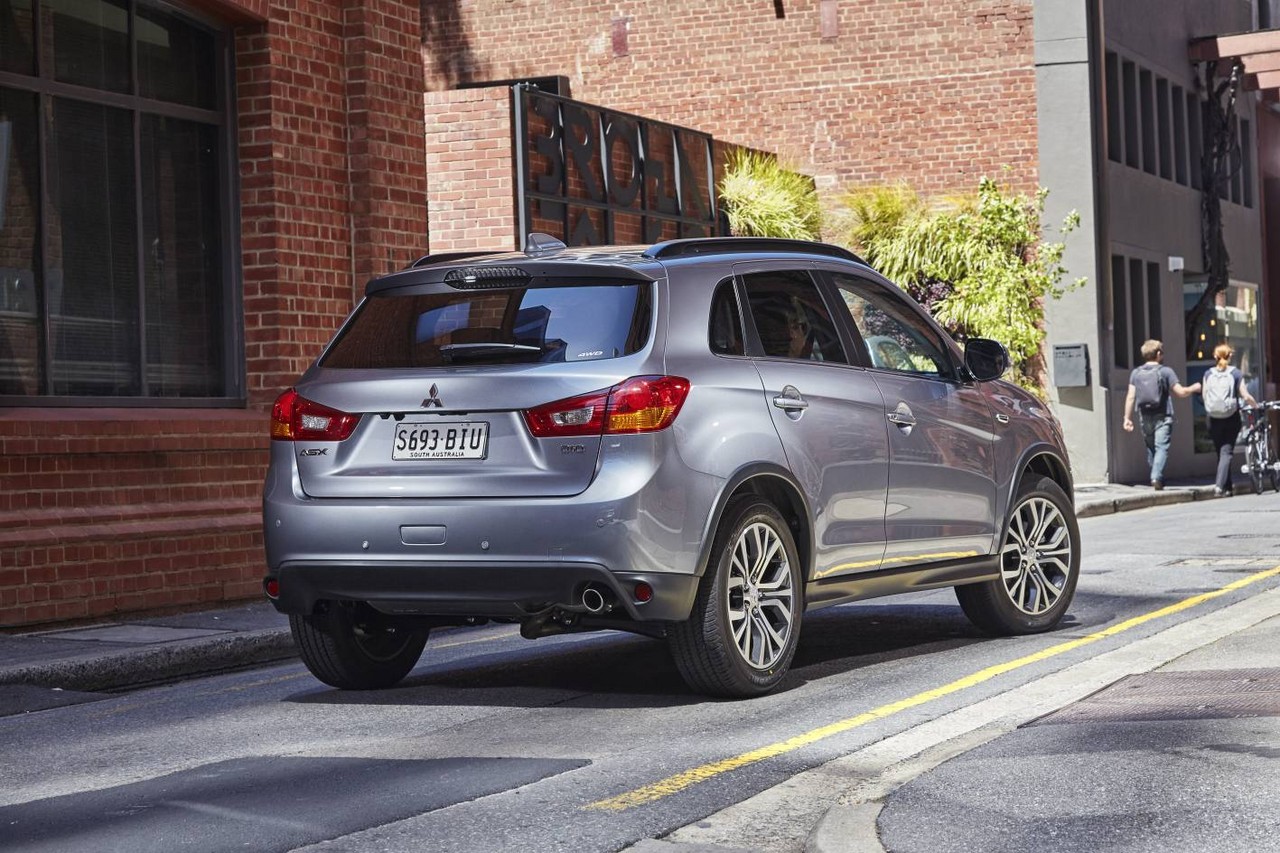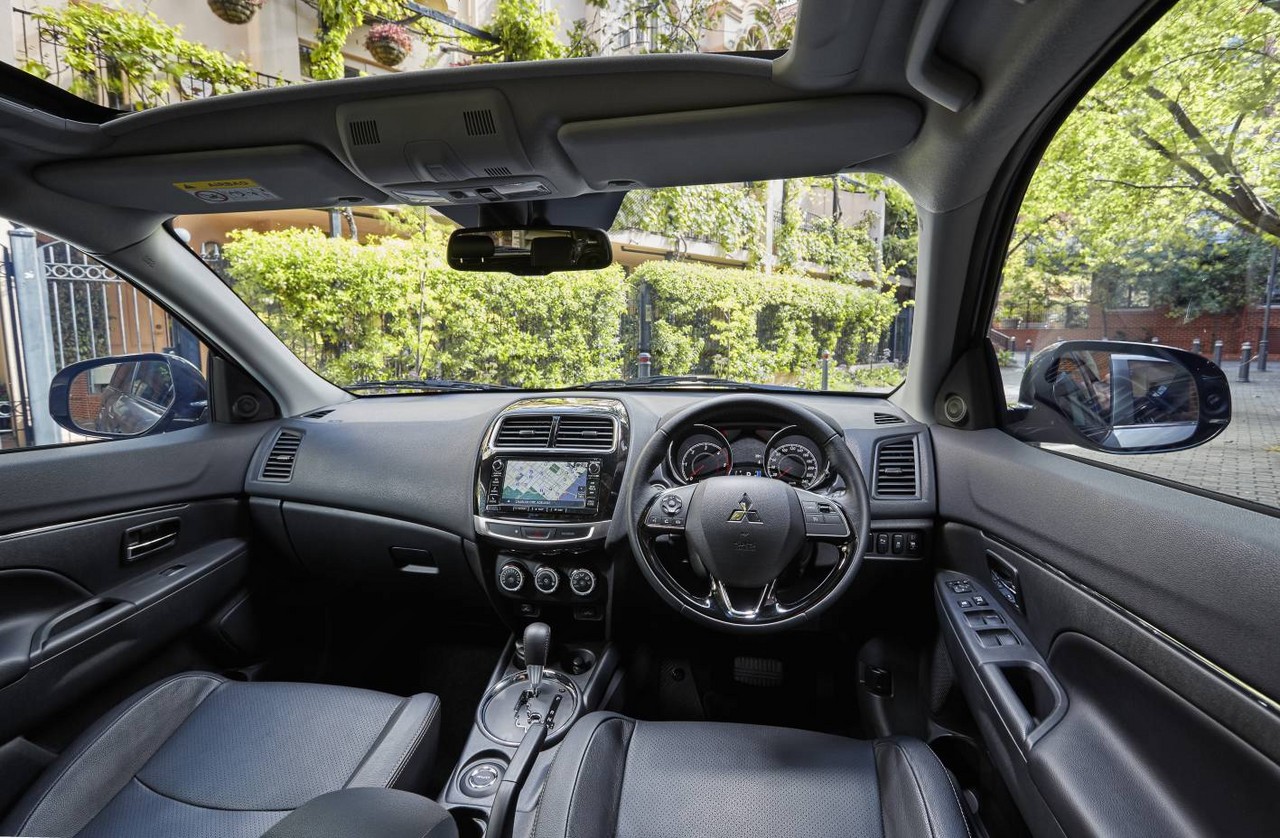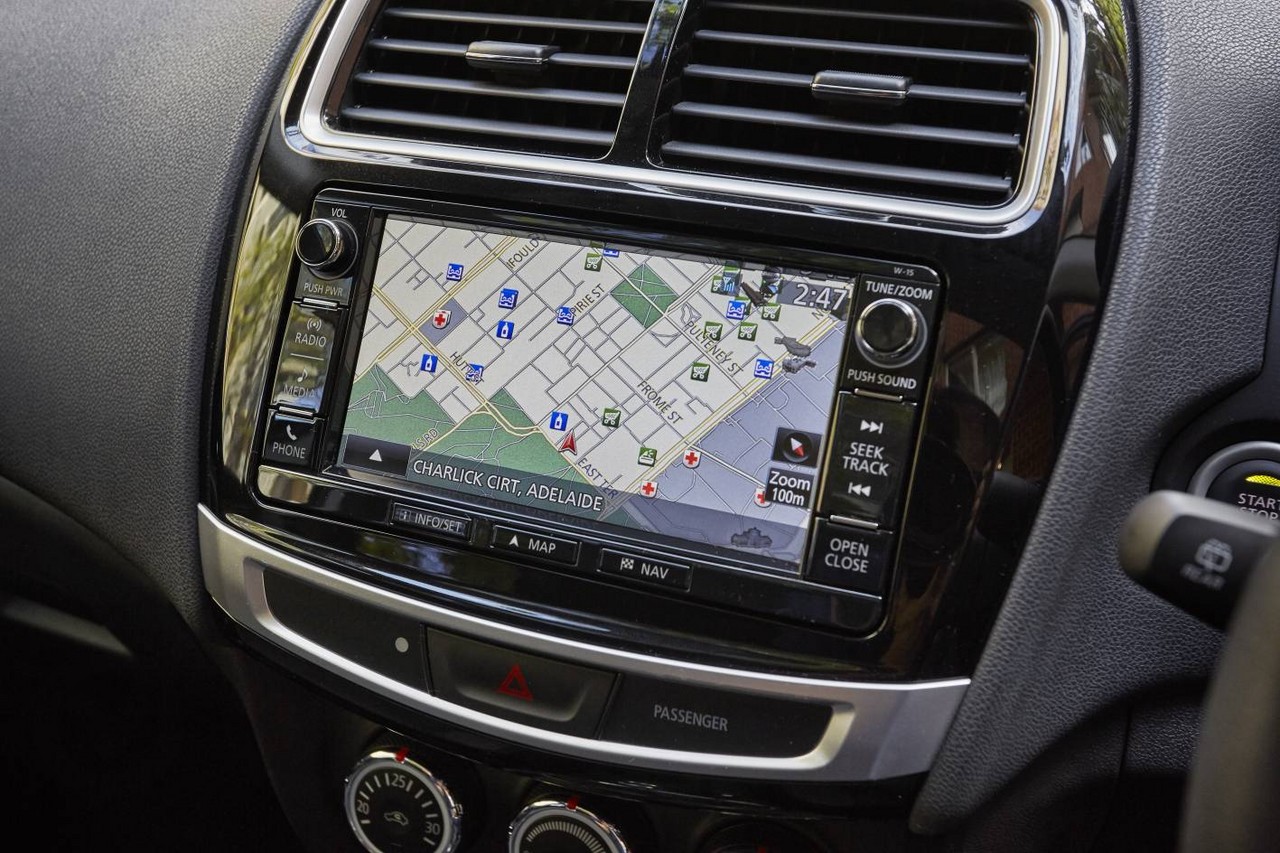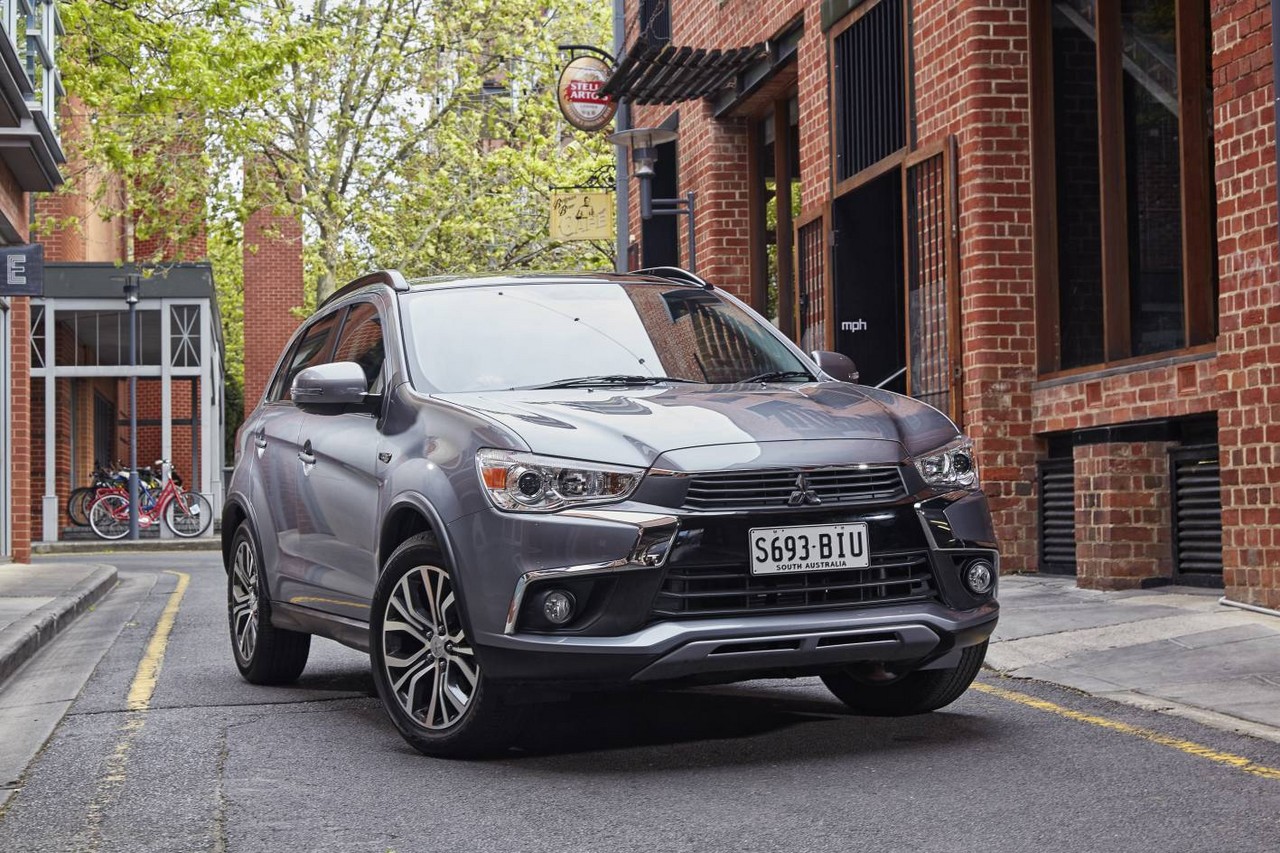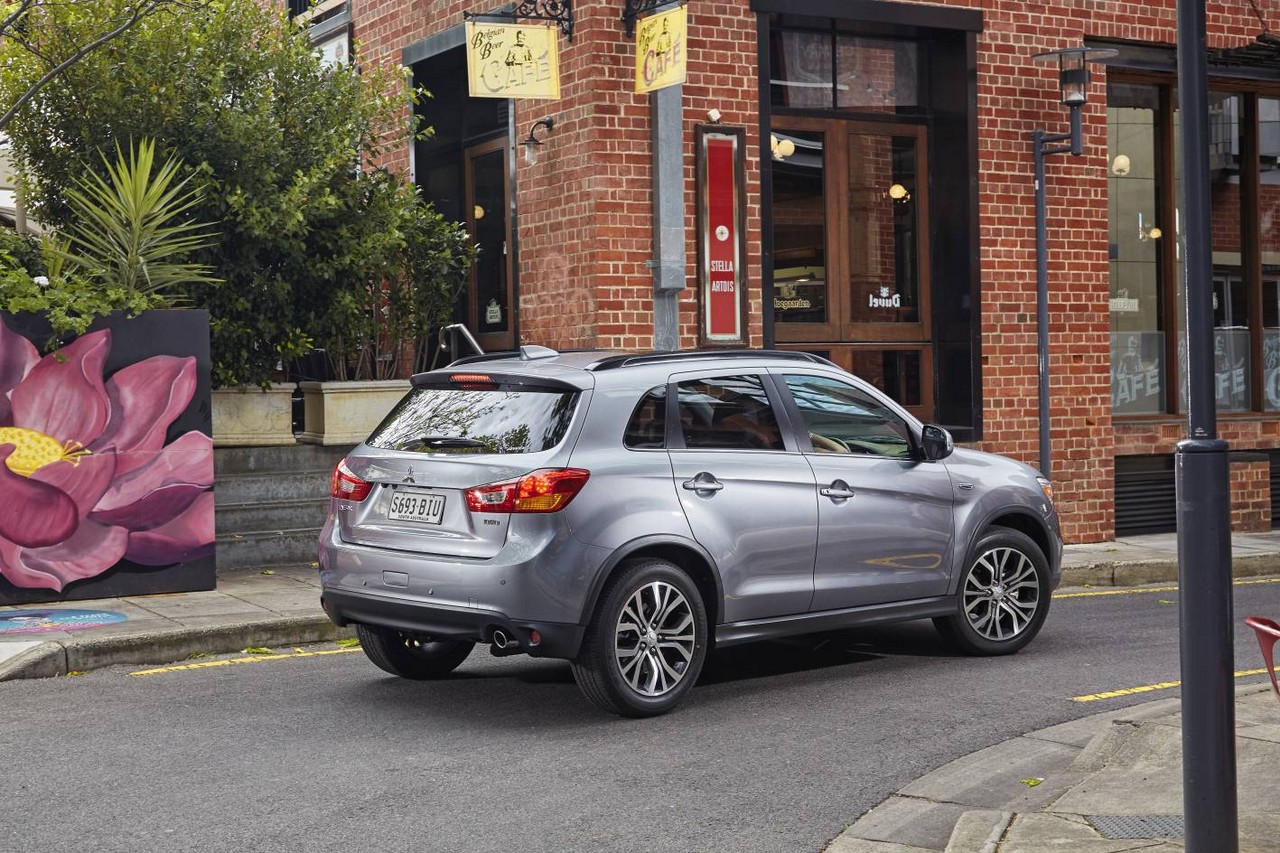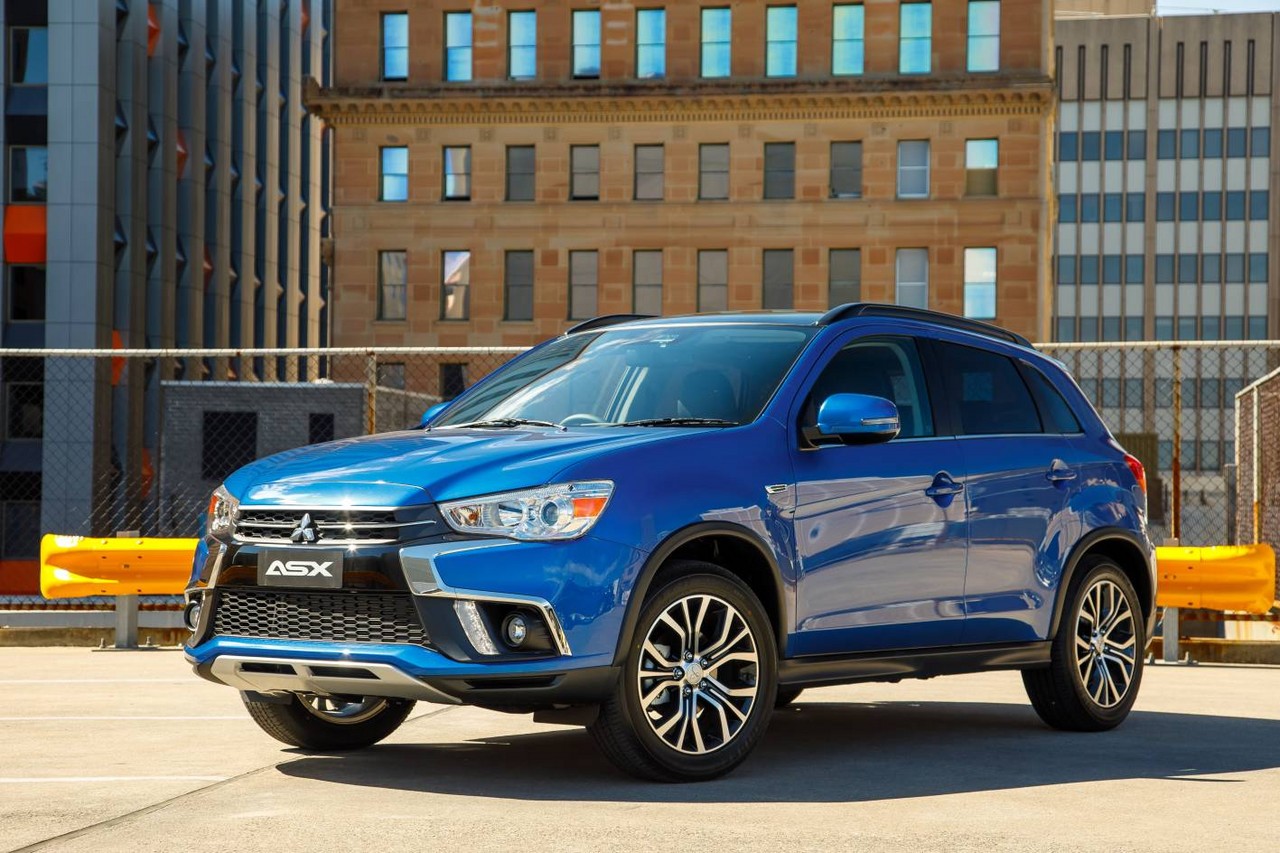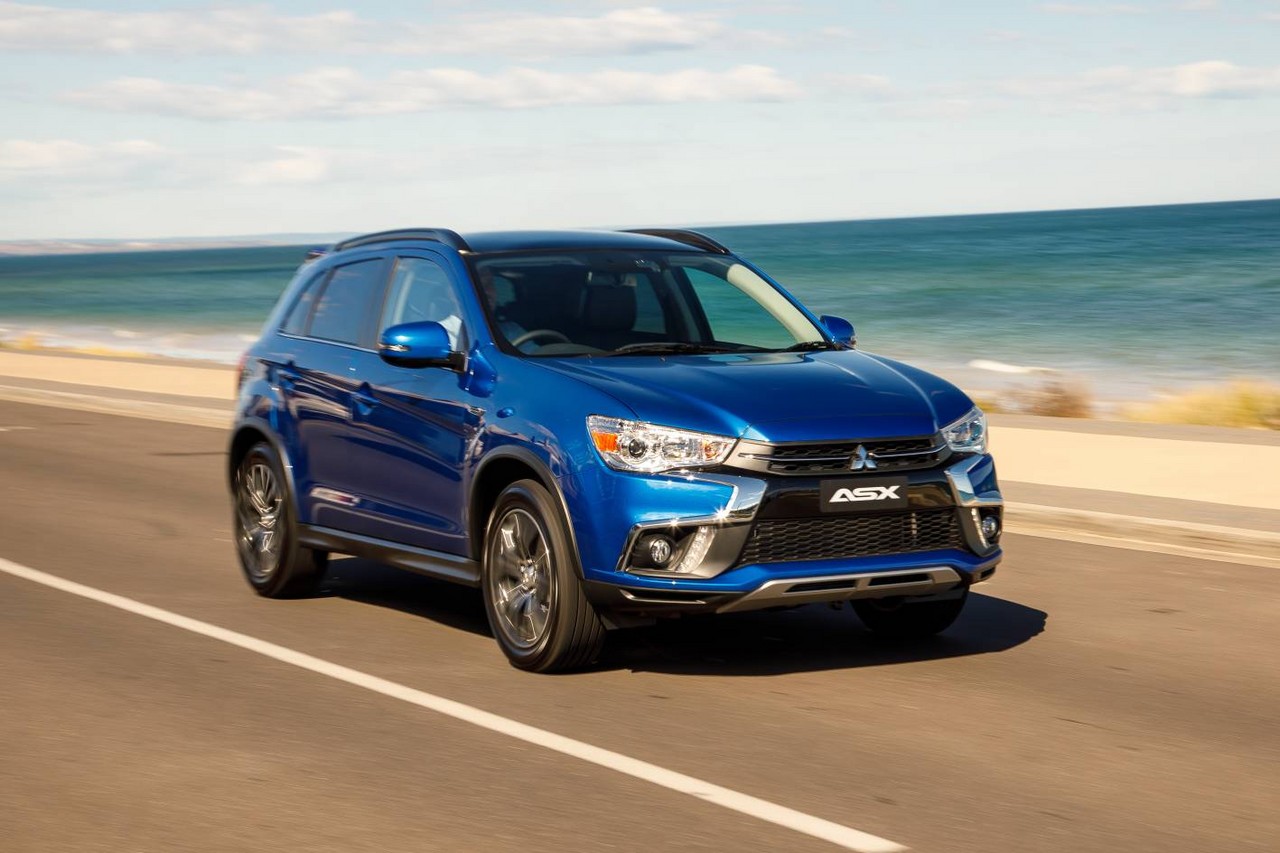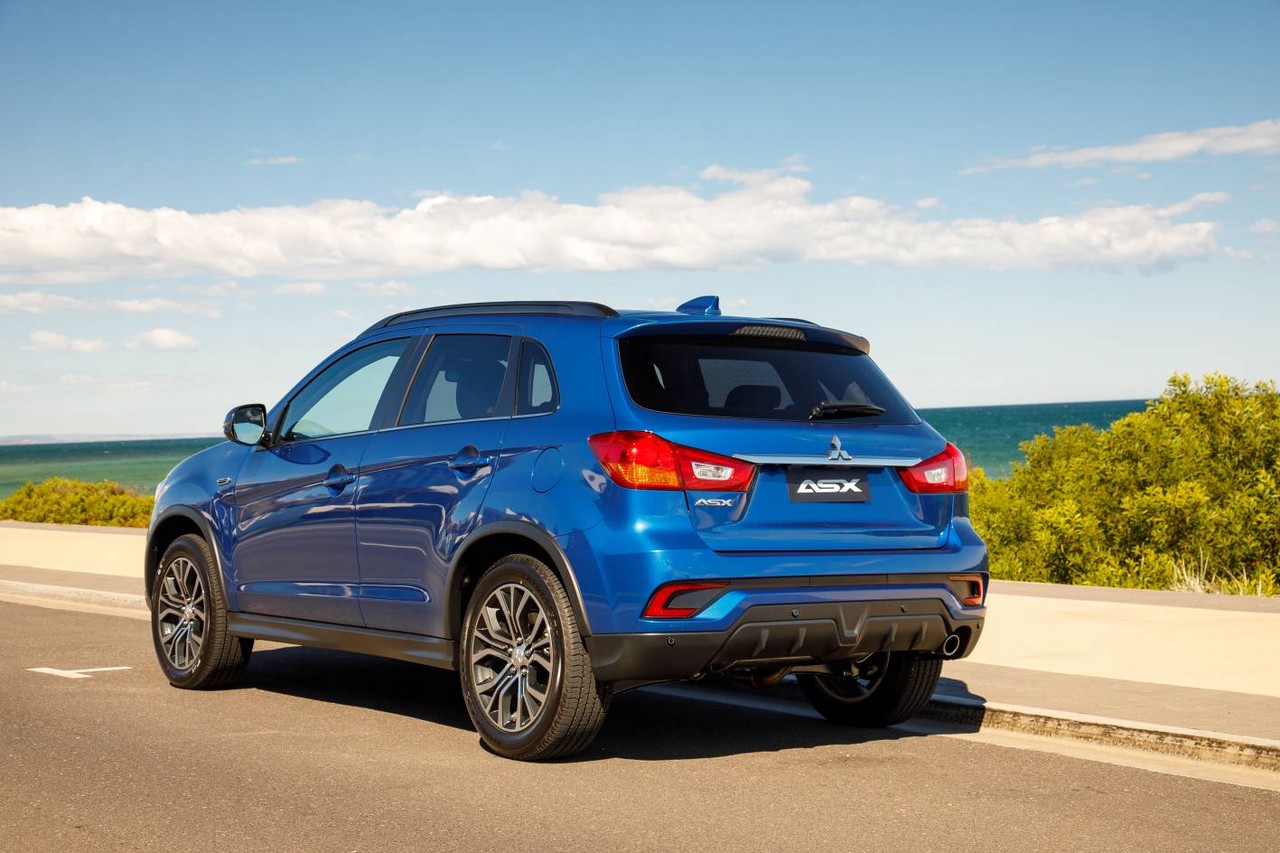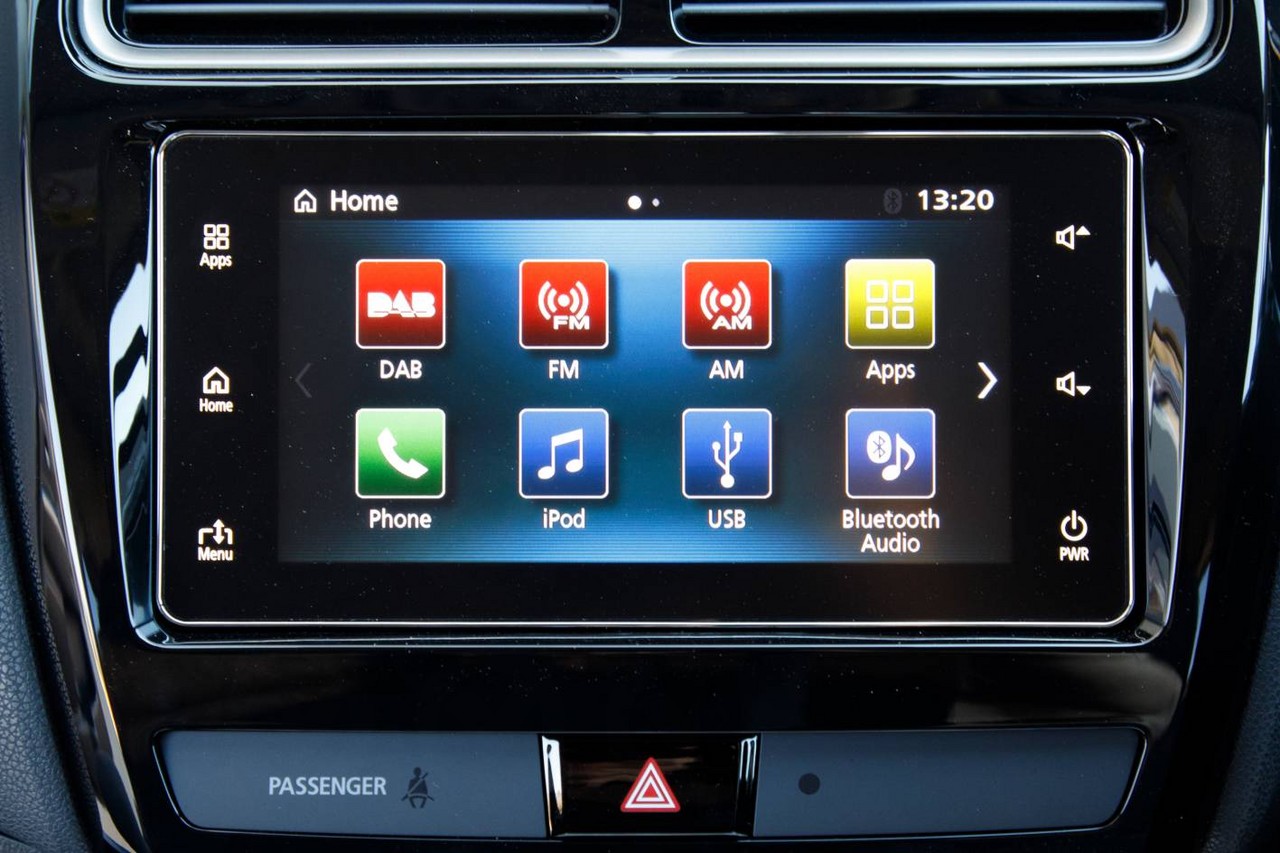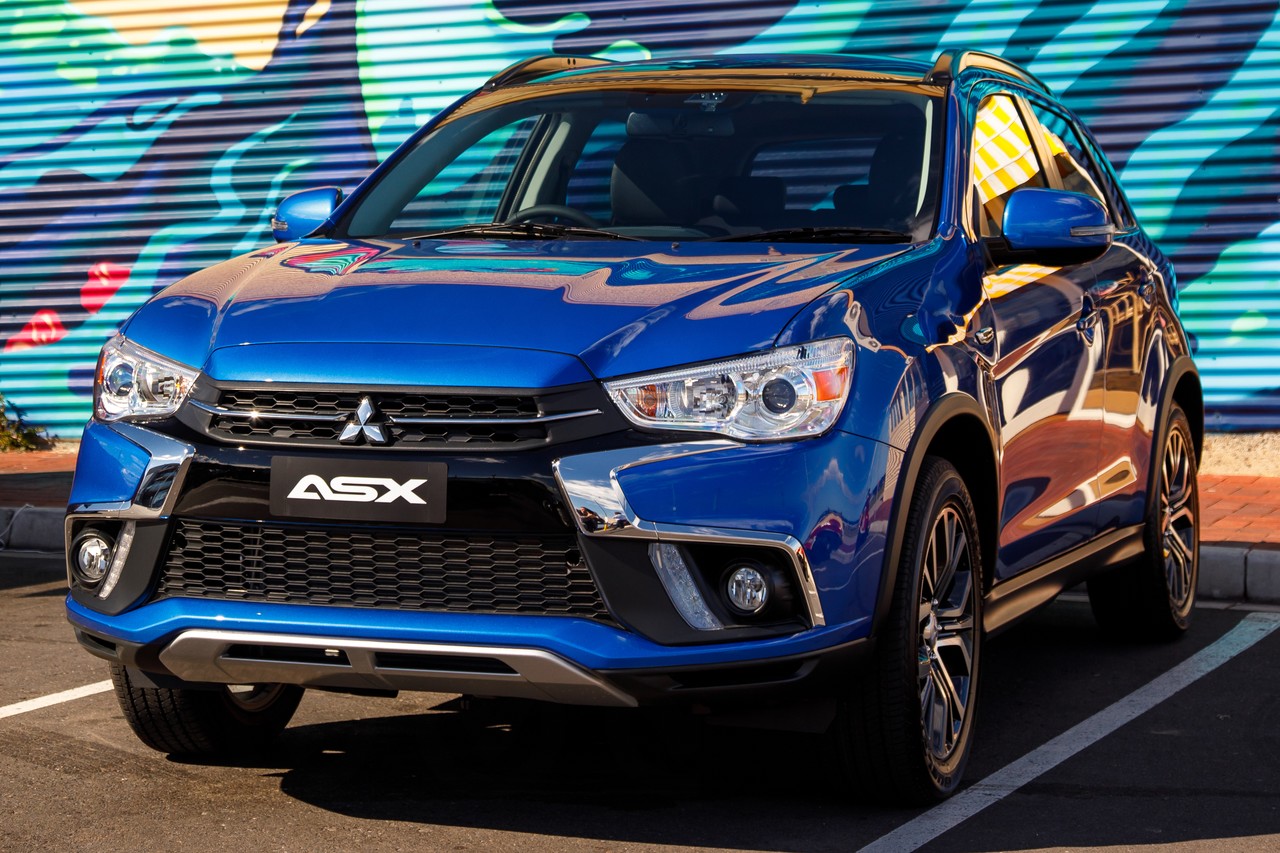
- Frugal turbo-diesel engines
- Five-year warranty
- Good interior and cargo space
- Generally comfortable ride…
- … though suspension lacks low-speed compliance
- Cabin lacks sound insulation
- Where fitted, droning noise of CVT
- For 1.8-litre diesel engine, initial turbo lag and manual transmission lacks refinement
- Seats lack support
- Steering lacks feedback
Review: Mitsubishi XA ASX (2010-12)
Overview
Released in July 2010, the Mitsubishi XA ASX – short for ‘Active Sports Crossover’ – was a compact SUV that was available with front- or all-wheel drive. Manufactured in Okazaki, Japan, the all-wheel drive models were powered by either a 2.0-litre four-cylinder petrol engine that was mated to a continuously variable transmission (CVT) with six pre-set ratios, or a 1.8-litre four-cylinder turbo-diesel engine that was mated to a six-speed manual transmission. The front-wheel drive models were solely available with the petrol engine, but were also offered with a five-speed manual transmission. Furthermore, the ASX range consisted of an unnamed, entry-level variant and the Aspire.
| Engine | Drive | Variants | Trans. | Years | Peak power | Peak torque |
|---|---|---|---|---|---|---|
| 2.0-litre petrol I4 |
FWD | [Unnamed] | 5sp man., 6sp CVT |
2010-12 | 110 kW at 6000 rpm | 197 Nm at 4200 rpm |
| Platinum, Activ |
5sp man., 6sp CVT |
2012 | ||||
| AWD | [Unnamed], Aspire |
6sp CVT | 2010-12 | |||
| 1.8-litre turbo-diesel I4 | AWD | [Unnamed], Aspire |
6sp man. | 2010-12 | 110 kW at 4000 rpm | 300 Nm at 2000 rpm |
AWD system
The Mitsubishi ASX’s all-wheel drive (AWD) system had three selectable modes:
- 2WD: two-wheel drive for dry, tarmac roads and maximum fuel efficiency;
- 4WD: electronically-controlled all-wheel drive. In normal conditions, 85 per cent of the engine’s torque would be directed to the front wheels, though more torque could be directed to the rear wheels in the event that traction was lost or in the event of a sharp acceleration; and,
- LOCK: permanent four-wheel drive with 50 per cent more torque directed to the rear wheels (compared to ‘4WD’ mode), up to a maximum of 82 per cent.
Body and suspension
The Mitsubishi ASX had the same platform as the Mitsubishi Mk.2 Outlander , but its body was shortened such that the ASX was strictly a five-seat vehicle. Compared to the Mk.2 Outlander, the ASX was 345 mm shorter (at 4295 mm), 30 mm narrower (1770 mm), 115 mm lower (1625 mm) and had the same length wheelbase (2670 mm). Furthermore, the body itself had a coefficient of drag of 0.32.
The Mitsubishi ASX had MacPherson strut front suspension and independent, multi-link rear suspension.
Safety equipment
Standard safety equipment for the Mitsubishi ASX included dual front airbags, front side airbags, full-length curtain airbags (i.e. for front and rear occupants), a driver’s knee airbag, ABS, electronic brake force distribution, electronic stability control, traction control, hill start control and front seatbelts with pretensioners and force limiters.
ANCAP and Euro NCAP testing
In ANCAP crash testing , a front-wheel drive Mitsubishi ASX with a 2.0-litre petrol engine received a five star adult occupant protection rating with a score of 34.13 out of 37. In the frontal impact offset test, protection from serious leg injury was marginal for the driver. Furthermore, maximum points were awarded in the side and pole impact tests.
In Euro NCAP testing , a front-wheel drive Mitsubishi ASX with a 1.8-litre turbo-diesel engine achieved a five star safety rating which included an 86 per cent adult occupant protection rating and a 78 per cent child occupant protection rating. In the frontal impact offset test, the passenger compartment remained stable with only slight deformation of the windscreen pillar; protection of the driver’s feet and ankles, however, was rated as marginal. Like the ANCAP test, maximum points were awarded in the side and pole impact tests.
Features: Mitsubishi ASX
Standard features for the front-wheel drive Mitsubishi ASX included 16-inch alloy wheels with 215/65 R16 98H tyres, a four speaker sound system with CD player, MP3-compatiblity, USB and auxiliary inputs, climate control air conditioning, cruise control, leather-wrapped steering wheel and gearshift, a 60/40 split and folding rear seat, remote central locking, power windows and folding mirrors, a tilt and reach adjustable steering wheel, height adjustable driver’s seat, trip computer, roof rails and an immobiliser. An optional Luxury Pack added 17-inch alloy wheels, leather seats, a power adjustable driver’s seat, heated front seats, front fog lights, Bluetooth phone connectivity with steering wheel controls and steering wheel audio controls.
Compared to their front-wheel drive counterparts, the all-wheel drive Mitsubishi ASX models were further equipped with front fog lights, Bluetooth phone connectivity with steering wheel controls, steering wheel audio controls, rear parking sensors and a chrome exhaust.
The ASX Aspire featured 17-inch alloy wheels with 215/60 R17 96H tyres, a nine speaker Rockford Fosgate sound system (including subwoofer) with a CD player, Mitsubishi Multi Communication System (MMCS) with seven-inch LCD, satellite navigation and 40GB hard drive, a power adjustable driver’s seat, leather seat facings, heated front seats, reversing camera, automatic headlights, rain-sensing wipers, rear centre armrest, privacy glass and smart key; CVT models were also fitted with steering-wheel gearshift paddles. Due to the addition of MMCS, the USB input and Bluetooth wireless transfer were not available on the Aspire.
August 2011: Mitsubishi ASX update
In August 2011, the ASX underwent a minor update with new seat trims and a rear-seat armrest with cupholders introduced across the range. Furthermore, all-wheel drive models were fitted with a reversing camera as standard, though it was viewed via a display within the electrochromatic rear view mirror (unlike the dashboard monitor used in the Aspire). The Aspire received additional interior chrome highlights.
An optional ‘Convenience Pack’ was introduced which added rear parking sensors, Bluetooth phone connectivity with remote control and steering wheel audio controls. Furthermore, the optional Luxury Pack was enhanced to include a reversing camera (within the electrochromatic rear view mirror).
2012 Mitsubishi ASX Platinum
Released in January 2012, the limited-run Platinum variant was based on the entry-level, front-wheel drive ASX. However, the Platinum variant was further equipped with leather seats, heated front seats, front fog lights, rear parking sensors, a reversing camera (displayed within the rear view mirror), steering wheel audio and Bluetooth controls. Visually, the Platinum variant could be identified by its chrome exhaust tip and ‘Platinum’ tailgate badge.
2012 Mitsubishi ASX Activ
In April 2012, a limited-run Activ variant was released. Compared to the standard front-wheel drive ASX, the Activ was further equipped with 17-inch alloy wheels, Bluetooth connectivity and steering-wheel Bluetooth and audio controls. Visually, the Activ could be identified by its chrome exhaust tip and bodykit which included front and rear air damps and a front bumper cover.
Related links
Review: Mitsubishi XB ASX (2012-14)
Overview
Released in September 2012, the Mitsubishi XB ASX introduced a revised range as the Aspire was offered as a front-wheel drive model and the turbo-diesel engine was only available in Aspire variants. Furthermore, mechanical improvements for the XB ASX included revisions to the multi-link rear suspension and recalibration of the CVTs for stronger acceleration and smoother operation.
Visually, the XB ASX could be identified by its less aggressive front fascia (including the front bumper, trapezoidal grille and recessed fog light housings) and new rear bumper. Inside, there were chrome accents for the air conditioning dials and instrument meter, while the entry-level variants were also fitted with higher quality seat fabrics. In July 2013, a 2.2-litre turbo-diesel engine was introduced; it was mated to a six-speed automatic transmission.
August 2013 (‘2014MY’) ASX update
In August 2013, the XB ASX was updated with changes including improved fuel economy for the 2.0-litre petrol engine, revised suspension bushings for improved ride comfort, reshaped rear seats and additional noise insulation material; standard features were also improved (detailed below).
| Engine | Drive | Variants | Trans. | Years | Peak power | Peak torque |
|---|---|---|---|---|---|---|
| 2.0-litre petrol I4 |
FWD | [Unnamed], Aspire |
5sp man., 6sp CVT |
2012-14 | 110 kW at 6000 rpm | 197 Nm at 4200 rpm |
| Aspire | 5sp man. | 2012-13 | ||||
| 6sp CVT | 2012-14 | |||||
| AWD | Aspire | 6sp CVT | 2012-14 | |||
| 1.8-litre turbo-diesel I4 | AWD | Aspire | 6sp man. | 2012-14 | 110 kW at 4000 rpm | 300 Nm at 2000 rpm |
| 2.2-litre turbo-diesel I4 | AWD | Aspire | 6sp auto | 2013-14 | 110 kW at 3500 rpm | 360 Nm at 1500-2750 rpm |
Features
Compared to their XA predecessors, the entry-level XB ASX variants received a new audio system with iPod compatibility, Bluetooth mobile phone connectivity with voice recognition and a new steering wheel with audio and Bluetooth controls. The Aspire variants gained a 6.1-inch colour touch screen which could be used to control the audio system and display the rear view camera (which included parking reference lines).
August 2013: ASX update
In August 2013, standard features were extended to include 17-inch alloy wheels, a 6.1-inch touch screen display, rear parking sensors and a reversing camera with parking reference lines.
Related links
Review: Mitsubishi XC ASX (2014-16)
Overview
Released in May 2014, the Mitsubishi XC ASX introduced a revised range, updated styling and other improvements. As part of the update,
- the 1.8-litre turbo-diesel engine was discontinued;
- the 2.0-litre petrol engine was reserved for front-wheel drive models;
- the 2.2-litre turbo-diesel engine was reserved for all-wheel drive models; and,
- the XC ASX range consisted of LS and XLS variants (see table below).
Visually, the XC ASX could be identified by its daytime running lamps (DRLs), new-design 17-inch alloy wheels designs, black roof rails and Emergency Stop Signal (ESS) brake lights which would flash during emergency braking manoeuvres. Changes for the XC ASX included improved ride comfort, stability, steering feel and NVH (noise, vibration and harshness) refinements.
For models with continuously variable transmissions (CVTs), Mitsubishi claimed improved ‘acceleration feel’ and improved fuel economy (7.4 litres per 100 km over the combined ADR 81/02 test cycle).
| Engine | Drive | Variant | Trans. | Peak power | Peak torque |
|---|---|---|---|---|---|
| 2.0-litre petrol I4 | FWD | LS | 5sp man., 6sp CVT |
110 kW at 6000 rpm | 197 Nm at 4200 rpm |
| XLS | 6sp CVT | ||||
| 2.2-litre turbo-diesel I4 | AWD | LS, XLS |
6sp auto | 110 kW at 3500 rpm | 360 Nm at 1500-2750 rpm |
Features
Standard features for the Mitsubishi ASX LS included 17-inch alloy wheels, a four speaker sound system with a CD player, MP3-compatiblity, auxiliary inputs (3.5 mm/USB/iPod), Bluetooth phone connectivity with voice recognition and 6.1-inch colour touch screen, climate control air conditioning, cruise control, daytime running lights, rear parking sensors, a reversing camera with parking guidelines, a leather-wrapped steering wheel and gearshift, 60/40 split and folding rear seats, remote central locking, power windows and folding mirrors, a tilt and reach adjustable steering wheel, height adjustable driver’s seat, rear privacy glass, trip computer, black roof rails and an immobiliser.
The ASX XLS was further equipped with a Mitsubishi Multi Communication System with a seven-inch touch screen and satellite navigation (including 3D maps and SD card audio input), leather seat trim, a power adjustable driver’s seat, heated front seats, automatic headlights, rain-sensing wipers and a panoramic glass roof with power-operated sun shade.
June 2015 update
In June 2015, the Mitsubishi ASX was updated with the following changes:
- All models were fitted with 18-inch alloy wheels, black wheel arch extensions and a chrome tailgate extender;
- The audio system was upgraded and included digital audio broadcast (DAB) radio; and,
- There was a new steering wheel with piano black highlights and improved feel (previously introduced in the 2015 Outlander).
Brochure
Related links
Review: Mitsubishi XD ASX (2016-17)
Overview
Released in Australia in November 2016, the Mitsubishi XD ASX introduced visual and interior updates, though the range was unchanged. The XD ASX could be identified by its Mitsubishi’s ‘Dynamic Shield’ styling, with changes including a new front bumper and grille, front fog lamps (replacing daytime running lights), gloss black and chrome finishes, and a new shark-fin antenna.
| Engine | Drive | Variant | Trans. | Peak power | Peak torque |
|---|---|---|---|---|---|
| 2.0-litre 4B11 petrol I4 | FWD | LS | 5sp man., 6sp CVT |
110 kW at 6000 rpm | 197 Nm at 4200 rpm |
| XLS | 6sp CVT | ||||
| 2.2-litre 4N11 turbo-diesel I4 | AWD | LS, XLS |
6sp auto | 110 kW at 3500 rpm | 360 Nm at 1500-2750 rpm |
Safety equipment
Compared to the Mitsubishi XC ASX, standard safety equipment for the XD ASX was unchanged.
Features
Compared to the XC ASX, features for the Mitsubishi XD ASX were largely unchanged. However, the greater rear seat base bolstering was introduced for greater comfort, while the ASX LS variants received new seat fabrics with red stitching.
For the ASX XLS, the seat heating switches were relocated to the instrument panel, while a new menu structure was introduced for the Mitsubishi Multimedia Communication System (MMCS).
Specifications
Review: Mitsubishi XE ASX (2017-on)
Overview
Released in Australia in September 2017, the Mitsubishi XE ASX range was expanded with an LS ADAS (‘Advanced Driver Assist Systems’) variant and its active safety technologies were shared with the ASX XLS (see ‘Safety equipment’, below).
Visually, the Mitsubishi XE ASX could be identified by its revised design for the front mask (Mitsubishi’s ‘Dynamic Shield’) with integrated LED daytime running lamps and lower fog lamp bezels. At the rear, there was a new rear bumper and tailgate design.
Inside, changes included a silver finish with a geometric pattern for the floor console panel, the introduction of soft knee rests, a new armrest with a larger console box and a new design for the gearshift lever for models with automatic transmissions. To reduce interior noise, ‘new acoustic absorption materials [were] introduced throughout the body’.
September 2018 update
In September 2018, the Mitsubishi XE ASX range was revised as diesel engines were withdrawn, an ES variant was introduced and the XLS was effectively replaced by the Exceed.
| Engine | Drive | Variant | Trans. | Peak power | Peak torque |
|---|---|---|---|---|---|
| 2.0-litre 4B11 petrol I4 (2017-on) |
FWD | ES, LS |
5sp man., 6sp CVT |
110 kW at 6000 rpm | 197 Nm at 4200 rpm |
| ES ADAS, MR, LS, LS ADAS, XLS, Exceed |
6sp CVT | ||||
| 2.4-litre 4B12 petrol I4 (2019-on) |
FWD | Exceed, GSR |
CVT | 123 kW at 6000 rpm | 222 Nm at 4100 rpm |
| 2.2-litre 4N11 turbo-diesel I4 (2017-18) |
AWD | LS, XLS |
6sp auto | 110 kW at 3500 rpm | 360 Nm at 1500-2750 rpm |
Safety equipment
For the Mitsubishi XE ASX, the LS ADAS and XLS variants were equipped with Mitsubishi’s ‘Advanced Driver-Assist System’ (ADAS) which included –
- Forward Collision Mitigation: used a camera and radar sensor to detect vehicles (at speeds from 5 km/h to 80 km/h) and pedestrians (at speeds from 5 km/h to 65 km/h). In its first stage, the driver would receive audible and visual warnings, and the braking system would be prepared to brake application. In its second stage, the warnings would continue and partial braking would be initiated. In its final stage, when a collision was assessed to be imminent, maximum braking force would be applied;
- Lane Departure Warning; and,
- Automatic high beams.
From September 2018, the Advanced Driver-Assist System (ADAS) – fitted as standard to the ES ADAS and Exceed variants – consisted of:
- Forward Collision Mitigation (FCM);
- Blind Spot Warning (BSW) and Lane Change Assist (LCA);
- Lane Departure Warning (LDW); and,
- Rear Cross Traffic Alert (RCTA).
Features
For the Mitsubishi XE ASX, standard features were extended to include Mitsubishi’s ‘Smartphone link Display Audio’ (SDA) system – which had a seven-inch display, two USB ports and a mobile phone tray with a removable padded liner – and a digital radio tuner (DAB).
Relative to the Mitsubishi XE ASX LS, the LS ADAS variant was further equipped with an electro-chromatic rear view mirror, rain-sensing wipers and dusk-sensing headlamps.
For the features of the post-September 2018 Mitsubishi ASX, please refer to the brochure below.
2018 Mitsubishi ASX Black Edition
The Mitsubishi ASX Black Edition was released in Australia in September 2018. Solely available with a CVT and based on the ASX ES, the ASX Black Edition could be identified by its gloss black alloy wheels, door mirrors and front skid plate, chrome exhaust tip and privacy glass.
Compared to the ASX ES, the Mitsubishi ASX Black Edition included was further equipped with front fog lamps, rear parking sensors, a proximity key, push-button start and integrated indicators in the door mirrors. Inside, the ASX Black Edition featured leatherette bolsters with micro-suede trim for the seats, red aluminium pedals, a carbon fibre pattern on the centre panel and red stitching accents for the steering wheel, gear shift knob and park brake.
October 2019 update (‘MY20’)
The ‘2020 model year’ (or ‘MY20’) Mitsubishi ASX was released in Australia in October 2019. As part of this update,
- Forward Collision Mitigation was fitted as standard across the range, while an electrochromatic rear view mirror was also standard;
- A 2.4-litre petrol engine was introduced for Exceed and newly-introduced GSR variants;
- MR and GSR variants were introduced, the latter equipped with a CVT that had six pre-set ratios and steering wheel gearshift paddles;
- A new infotainment system was introduced which had an eight-inch touchscreen (previously seven-inch), Apple CarPlay and Android Auto smartphone integration, Bluetooth mobile phone connectivity and audio streaming; and,
- The ASX Exceed was equipped with a Rockford Fosgate premium audio system, TomTom navigation system and leather seats.
Visually, the ‘2020 model year’ Mitsubishi ASX could be identified by its re-shaped front bumper and grille which had black and chrome finishes.
For a complete list of features for the ‘2020 model year’ Mitsubishi ASX, please see the Mitsubishi XE ASX Brochure (October 2019 ).
Brochures
- Brochure: Mitsubishi XE ASX (October 2017)
- Brochure: Mitsubishi XE ASX (September 2018)
- Brochure: Mitsubishi XE ASX (October 2019)
Related links
